
Hello… an exciting new opportunity has just become available at a local leading Insurer. We are looking to recruit a Risk Consultant for the Eastern Cape, working out of the local Insurer’s office situated in the East London.
Role Objectives:
• Responsible for the protection of the company with respect to over exposure from a risk management perspective by conducting accurate fire, security and insurance p eril risk assessments as well as the submission of accurate MPL (maximum probable loss) scenarios and risk reports. The risk reporting system is an electronic tool which generates reports automatically.
Key Responsibilities:
• Evaluate buildings and structures (physically or based on plans) to establish the level of compliance with regards to insurance requirements, legislation, regulations and codes of practice and provide an informed opinion of the possible impact of non -compliance and propose alternatives to mitigate such non -compliance.
• Evaluate risk, evaluate loss potential, make requirements / recommendations for risk improvements where necessary and advise the company on whether to participate or come off risk on properti es.
• Carry out physical surveys timeously and professionally (within agreed times).
• Provide complete and professional reports in order for Underwriters to have a clear picture of all the risks involved.
• Stakeholder management: - Take ownership of queries and offer possible solutions to the various stakeholders / clients and ensure all are resolved and feedback given to relevant parties.
• Continuously build and manage the relationship between Risk consultants & Branch and broker network.
Required Knowledge, Experience and Skills:
• We are seeking a senior candidate with qualifications and experience in fire technology and or fire engineering with a strong solid fire prevention / fire safety background, preferably with a fire prevention/safety fire department background.
• 3 years’ experience in building fire prevention / fire safety and or fire codes approvals.
• Experience within surveying Insurance risks is advantageous but not essential.
• We will teach you the insurance aspects related to t he risk evaluations - we need your fire expertise.
Educational Requirements:

• Matric.
• Graduate member (or higher) of the Institution of Fire Engineers (IFE) or Diploma (or higher) in Fire Technology or Fire Engineering or National Diploma in Safety or C FPA Advanced Diploma in Fire Prevention / Safety or a suitable equivalent qualification.
Additional Requirement/s:
• Valid driver’s license.
Salary & Benefits:
• Company vehicle with vehicle fuel and maintenance card.
• Limited personal fuel and travel costs.
• Study assistance and further role related learning interventions.
• Medical aid.
• Pension or Provident Fund.
• Comprehensive Group life and dread diseases cover.
• Competitive market remuneration.
• Performance related bonus.
Please email your CV to Insurerecruiter@hollard.co.za
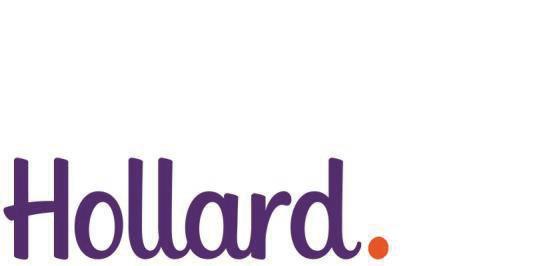
HOLLARD LIFE ASSURANCE COMPANY LIMITED, Reg. No. 1993/001405/06 Hollard is an authorised Financial Services Provider Hollard Villa Arcadia, 22 Oxford Road, Parktown, Gauteng, 2193 PO Box 87428, Houghton, 2041
“Applications for this role will be prioritised in line with our transformation objectives as per our Employment Equity Plan”
Contents
2 Comment Competition

3 FRI Images
Toughest Fire Fighter Alive South Africa
4 Toughest Fire Fighter Alive South Africa: What an experience!
Wildfires: 13th Fire Management Symposium
11 Nelson Mandela University holds 13th Fire Management Symposium at its George Campus
JOIFF Africa Conference
18 The JOIFF Africa Conference review
Fire fighting foams
24 AECI Speciality Chemicals receives another clear audit from Dr Sthamer Hamburg
Industrial fires
26 DoseTech special risk industrial fire protection interview
30 New non-fluorinated Thunderstorm WNF33A foam concentrate advances fire protection for flammable liquid storage tanks
PPE and cancer prevention
45 Feedback from the SAPAESA annual general meeting
46 WHO launches the Emergency Medical Teams 2030 Strategy at Global Meeting to strengthen rapid response amid emergencies worldwide
Self-defence for first responders
47 Essential services being the target of crime in South Africa by Morné Mommsen
International award
48 The South African National Sea Rescue Institute scoops an international award for its survival swimming centres
Events
49 A-OSH Expo 2023: Putting people first with uncompromising OSH
52 Firexpo 2023: equipping industry professionals with optimal fire detection and management solutions
Disaster management technologies
54 Disaster management: Technology saves the day
Heritage
56 History of fire fighter gloves
What’s on 57 Upcoming events
Poem
Response times
40 Managing and leading change in the South African fire service of the future by Etienne du Toit
Search and rescue (SAR)
42 Rescue South Africa: Disaster response team on the brink of disaster

44 The current state of South African emergency medical services’ training by Oliver Wright
58 The loneliness of leadership by Andy Starnesdeceased
FIRE AND RESCUE INTERNATIONAL | 1 Volume 6 | No 6 Strap
32 Protecting you every step of the way: the history of Dräger SCBA
34 Battling an unseen danger: cancer amongst fire fighters
36 Response times - making the first ten minutes count by Colin Deiner Leadership
Emergency medical services
Volume 6 No 6
Integrated fire, rescue, EMS and incident command technology
Comment
Editor
Lee Raath-Brownie lee@fireandrescue.co
Cell 082 371 0190
Advertising advertising@fireandrescue.co
Design and layout
Marc Raath marc@fireandrescue.co
Digital newsletter
Pierre du Plessis pierre@fireandrescue.co
Accounts and circulation
Kelebogile Chimaliro accounts@fireandrescue.co subs@fireandrescue.co
Secretary Kelebogile Chimaliro pa@fireandrescue.co
Administration Kelebogile Chimaliro
Contributions
Africa
Colin Deiner
Etienne du Toit
Ian Scher
Oliver Wright
Morné Mommsen
USA
Andy Starnes
Publisher
Lee Raath-Brownie FIRE AND RESCUE INTERNATIONAL
Tel 011 452 3135/6 Fax 086 671 6920 Box 8299 Greenstone 1616 www.fireandrescue.co
Subscriptions
Free of charge
Contact: subs@fireandrescue.co
Copyright
All rights reserved
We are proud to share our 59th edition of Fire and Rescue International (FRI), a dedicated technical magazine serving the emergency services that features interesting technical and research articles, inspiring leadership guidance as well as practical know-how for daily use. Enjoy the read!
Toughest Fire Fighter Alive South Africa
We bring you the best of the best from Toughest Fire Fighter Alive South Africa, which was hosted in Mossel Bay on the Garden Route.
Nelson Mandela University 13th Fire Management Symposium
We provide an indepth overview of the recently held 13th Fire Management Symposium, which was held by the Nelson Mandela University at its George Campus.
JOIFF Africa Conference
The JOIFF Africa Conference brought together the industrial, petro chemical and municipal fire industries and we share an indepth review of this prominent event.
Fire fighting foams
The AECI Speciality Chemicals manufacturing plant in Chloorkop, Gauteng, received another clear audit from DrSthamer Hamburg in Germany at its biennale audit.
Industrial fires
We share an informative interview with local South African company, DoseTech Fire and bring you the latest product from Industrial Fire and Hazard Control, the new nonfluorinated Thunderstorm WNF33A foam concentrate, which advances fire protection for flammable liquid storage tanks.

PPE and cancer prevention

We share the history of Dräger self-contained breathing apparatus (SCBAs) and provide some hands-on guidance to prevent cancer amongst fire fighters.
Response times - making the first ten minutes count
Colin Deiner discusses response times to incidents saying that the speed that fire departments respond to emergencies, is the single most important factor in determining the success or failure of the responding service. Deiner looks at the various phases of response such as call processing, turnout and travel, providing some hands-on advice as usual.
Leadership
Etienne du Toit looks at managing and leading change in the South African fire service of the future. In this article, Du Toit states that the fire service must transform to become a dynamic, forward-looking organisation, at the centre of the communities they serve, adapting to their evolving needs.
Search and rescue (SAR)
Ian Scher of Rescue South Africa shares the plight for the future existence of its disaster response team.
Emergency medical services
The South African Private Ambulance and Emergency Services Association’s (SAPAESA) Oliver Wright discusses the current state of South African emergency medical services’ training and provides feedback from the SAPAESA annual general meeting. We also share the World Health Organisation’s Emergency Medical Teams 2030 Strategy to strengthen rapid response amid emergencies worldwide.
Self-defence for first responders
Morné Mommsen looks at the current situation around the essential services being the target of crime in South Africa and solution to prevention.
Disaster management technologies
We share some interesting disaster management technologies to assist teams via an App during disaster response.
We thank all our contributors, advertisers and readers for their continued support! Fire and Rescue International is your magazine. Read it, use it and share it!
Lee Raath-Brownie
Publisher
2 | FIRE AND RESCUE INTERNATIONAL Volume 6 | No 6
Lee Raath-Brownie
Congratulations to
Ruan Matthee for his photograph ‘Burst into flames, rise from the ashes’ taken with a Huawei P Smart using automatic settings.
Well
done!
This month’s FRI Images winner!
Ruan Matthee wins this months prize money of R2000!

Photo description: A wildfire that swept through small holdings and claimed a thatch roof structure.

Best rescue, fire or EMS photo wins R2 000!
Fire and Rescue International’s (FRI) bi monthly photographic competition is open to all its readers and offers you the opportunity of submitting your digital images of fires, fire fighters, disasters, incidents, emergencies and rescues.

Rules
• All photographs submitted must be high resolution (minimum 1meg) in jpeg format
• Allowed: cropping, curves, levels, colour saturation, contrast, brightness, sharpening but the faithful representation of a natural form, behaviour or phenomenon must be maintained
• Not allowed: cloning, merging/photo stitching, layering of two photos into one final frame, special effects digital filters
Fire and Rescue International (FRI) reserves the right to publish (printed or digitally) submitted photographs with acknowledgement to the photographer
• Winners will be chosen on the merit of their photograph
• The judge’s decision is final and no correspondence will be entered into afterwards
Entries must include:
Name of photographer
Contact details (not for publishing)
Email (not for publishing)
Name of photograph
Brief description of photograph including type of incident
Camera, lens and settings used
All entries must be emailed to: lee@fireandrescue.co >>
FIRE AND RESCUE INTERNATIONAL | 3 Volume 6 | No 6
ENTER NOW! Images
Back to Contents
Toughest Fire Fighter Alive South Africa 2022: What an experience!
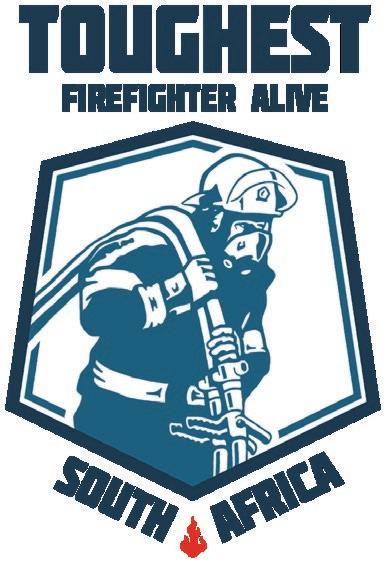

The 2022 Toughest Fire Fighter Alive South Africa (TFA SA) was held on 16 and 17 September 2022 at De Bakke Beach in Mossel Bay with Mossel Bay Fire, Rescue and Disaster Management Services being its host. TFA SA organiser, Mark Smith said, “This year, TFA was exceptional, the best so far. It was very encouraging to see the number of fire fighters, male and female,



attempting to do the gruelling circuit, displaying the grit and determination of South African fire fighters such as the camaraderie and the encouraging of teammates. Fire fighters were proud to represent their regions and many vowed to return better next as this only bodes well for the future of the event. Thank you to all the fire fighters, volunteers and sponsors. You made this a memorable TFA event.”
During the opening, Leon van Dyk, Mossel Bay MAYCO member of Council for Community Safety together with Etienne du Toit, deputy director: Fire Rescue Services for Western Cape Province and CFO Joseph Johnston, acting director of Community Safety and chief of Mossel Bay Fire, Rescue and Disaster Management Service provided participants, their families and attendees with much
4 | FIRE AND RESCUE INTERNATIONAL Volume 6 | No 6 Strap
Toughest Fire Fighter Alive South Africa
“It was very encouraging to see the number of fire fighters, male and female, attempting to do the gruelling circuit, displaying the grit and determination of South African fire fighters such as the camaraderie and the encouraging of teammates,” Organiser Mark Smith
Back to Contents
The 2022 TFA SA included a Mini TFA for children for the first time
motivation, speaking from the heart. The event MC was Platoon commander Johann Makwak of Mossel Bay Fire and Rescue Service.
The prize giving was held at the Mossel Bay Fire Station and Mossel Bay Mayor, Alderman Dirk Kotze, together with Etienne du Toit of Western Cape Province, CFO Joseph Johnston, Garden Route District Municipality Mayor Memory Booysen and TFA organiser, Mark Smith, handed over the trophies. Mayor Kotze shared quite a few inspirational quotes from his own experience as an athlete “Push through the pain’, from author Carol Dweck on grit and on leadership from authors Dr Myles Munroe and Arthur Ashe.
Winners: Individuals View PDF
Although the finishing times of the participants show their performance at the event, I believe that they are all winners by simply taking part in the Toughest Fire Fighter Alive South Africa 2022 with perseverance, grit and dog-headed determination. Although a competitive challenge, participants shared a deep camaraderie and built new connections while strengthening existing ones; TEAM WORK.

The overall winner of the TFA SA 2022 is 44-year-old Manie Gouws from West Rand with Baigum Abrahams of the City of Cape Town taking the top female position again. Emile Conrad from Garden Route District Municipality Fire Service came second, just a few seconds behind Gouws while Dale Alexander of the City of Cape Town Fire and Rescue Service came third. Lesego Molikwe came second and Pule third in the female challenge, both from West Rand. Molikwe also took winner of Best New Entrant Female.
The 44-year-old Gouws started working as a fire fighter in 1999 and is currently a paramedic in the service of Gauteng Province. He has competed internationally but never managed to secure the TFA SA title. In an interview after the prize giving, Gouws gave glory to God for his victory. The past four years, Gouws has been involved in training of the West Rand Team who did particularly well in the TFA competition. Gouws said that hard work, focus and dedication is the key to success. “And I always tell my team, just enjoy it. It’s one step at a time until you cross that finish line. I am content now that I finally got this title.”
Conrad the former title holder for five consecutive times commented on a special relationship between him and Gouws. “Manie has been chasing me for years. I am thrilled for him to have secured the title.”
It was Alexander’s first TFA and he also claimed the title of best newcomer in the male category.
Piet Niemann, the oldest fire fighter to compete in the challenge at 61 years of age, was given a standing ovation by his fellow fire fighters and guests as he was called to stage to receive his prize.
Winners: Relays View PDF West Rand took first place in the relay event for both male and female categories.
Mini TFA 2022
This year’s TFA SA included a Mini TFA for children for the first time. The event was open to kids aged three to 10 years’ old. Garden Route District Municipality’s Emile Conrad, organised the event, creating an exciting mini circuit, which was a copy of the TFA circuit with a mini Kaiser Force machine (built out of
FIRE AND RESCUE INTERNATIONAL | 5 Volume 6 | No 6
Toughest
Alive South Africa
Fire Fighter
Back to Contents
The 2022 TFA SA was held at De Bakke Beach in Mossel Bay
wood by Conrad and even a hose drag, hose carry and roll.
Conrad said, “It was such a joy and honour to put together the first Mini TFA event this year. Not knowing what to expect, we were blown away by the amazing turnout. Just over 70 kiddies registered on the day and competed in The Mini TFA event. The event featured a compilation of similar fire fighting tasks done in the National TFA competition. Kids had to perform hose drags and carries, mini Kaiser Force machine, crawling and moving over obstacles in the quickest possible time. The event was aimed at kids between the ages of three to 10 years old, hoping to inspire some future fire fighters and also to allow kids the opportunity to join in on the TFA in a fun and interactive way. We had really great feedback and the kids had huge amounts of fun.”
“All the kids received a gift pack and cupcakes, sponsored by Reel Cakes, as well as fire and life safety material, which were sponsored by Western Cape Province Disaster Management. We also had a lucky draw, giving away hampers sponsored by Nestlé as well as fire fighting puzzles and fire engine toys sponsored by Fire and Rescue International magazine. I would like to thank all the volunteers that helped on the day as well as all the sponsors. You made the event a huge success”, added Conrad.
Message from CFO Joseph Johnston, Mossel Bay Fire and Rescue Service
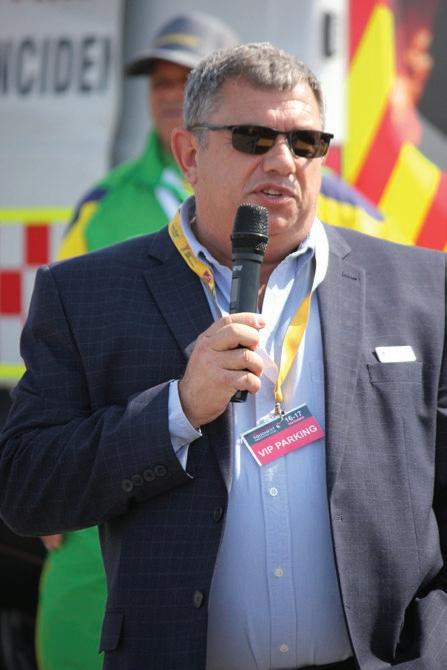
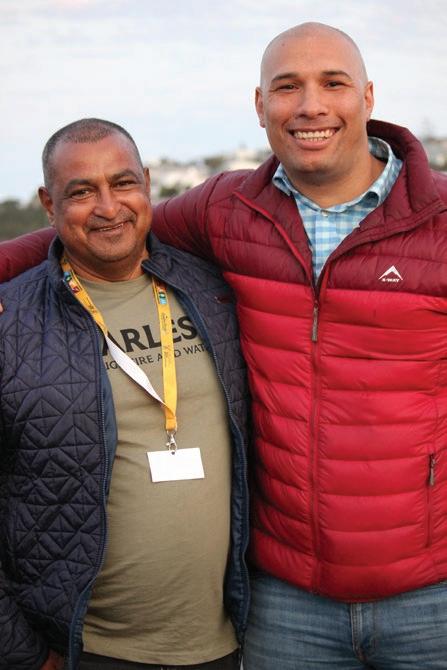
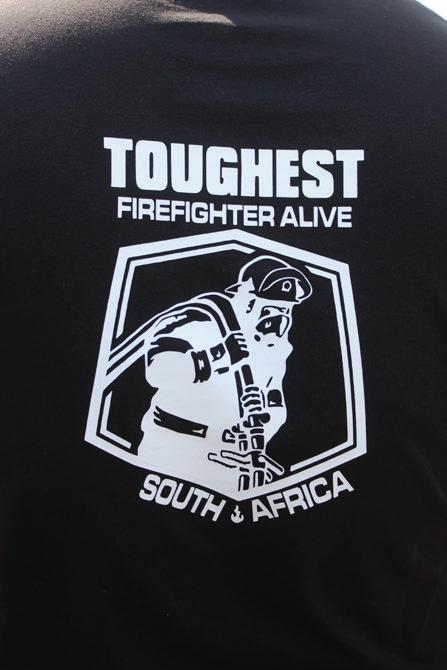
CFO Johnston summarised the eight most noteworthy traits that were displayed by fire fighter during the event as follows.
1. Drive: “Great fire fighters and leaders have set an expectation for themselves to be the best they can be and to not leave anything in the tank. They have a personal standard that they will not compromise. They have a can-do attitude with a relentless work ethic. For them, it’s not about if they will accomplish a goal but when they will accomplish it.”
2. Organisation: “Great fire fighters have a plan. They outline what they need to know, what classes and certifications they need to obtain, what skills they need to master. Then, they continue to stay sharp on those skills and work on their plan.”
3. Tenacity: “The fire service is a ‘doing’ business. When someone calls 911, they are not looking for advice or an opinion. They are looking for someone to show up now and solve their problem. Great fire fighters invest long hours training their minds and their bodies and practicing the skills that go into being a great fire fighter.”
4. Humility: “One of the most common traits of great fire fighters is their humility. The student is never greater than the teachers. Great fire fighters stay humble and continue to be students of great fire fighting throughout their careers.”
5. Self-control and persistence: “Find the most direct route to your goal, but don’t fall for the short-cut trap; there are none. Great fire fighters know that it takes discipline and time to maximize their potential. Great fire fighters have learned and exercise self-control to avoid burnout. They exercise persistence through to meet and exceed the challenge.”
6. Accountability: “It’s easy to point a finger and blame others or objects like an alarm clock when it doesn’t work. Great fire fighters always take 100 percent accountability 100 percent of the time because that is where the power is. It is where you find the power to improve and the power to adapt and overcome. Always be prepared with a backup plan.”
7. Inspiration: “Show me the five people you surround yourself with and I can tell you what your future holds. Humans are tremendously influenced by peer pressure. This peer

6 | FIRE AND RESCUE INTERNATIONAL Volume 6 | No 6
Toughest Fire Fighter Alive South Africa
TFA SA organisers Mark Smith and Ryan Abrahams
Back to Contents
Leon van Dyk, Mossel Bay MAYCO member of Council for Community Safety
pressure can work for us and against us. Great fire fighters know this and use it to their advantage. This is how they stay consistent and motivated in the pursuit of excellence.”
8. Thoughtfulness: “Fire fighters have so much to appreciate about those who have come before them. They blazed the trail and helped raise the quality of the fire service. We get to stand on the shoulders of those great fire fighters and leaders. Yet we also must plan for the future challenges. Join in making the fire service better by reminding yourself of the characteristics that you have and incorporating the ones you need to.”
“Each and every participant who entered excelled in completing the challenge and we will definitely welcome them and more at the 2023 event in Mossel Bay”, he added.
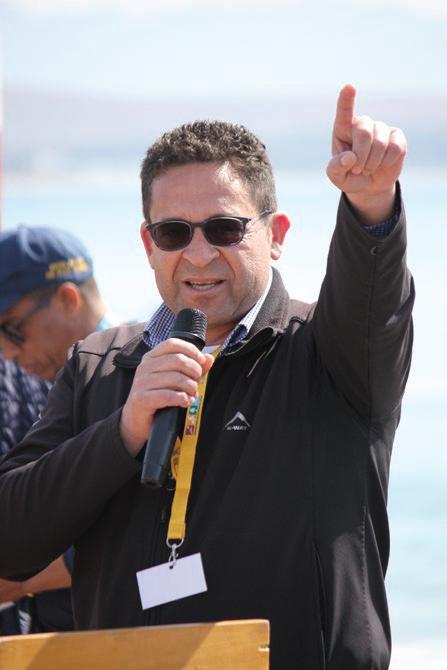
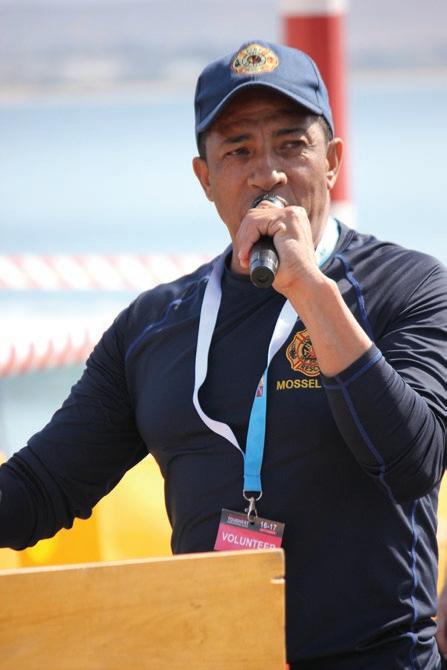
Comments

We have received numerous feedback and comments from the 2022 participants. These include:
Manie Gouws
Ongelooflike goeie atmosfeer. Goeie vertoning van krag, stamina en durf met goeie sportmanskap deur al die deelnemers.
Baigum Abrahams, City of Cape Town
It was an honour having the privilege to compete in the TFA SA 2022 again this year. The camaraderie that was fostered amongst all the fire fighters through the display of determination and grit, was truly a highlight of the event. Competing in the TFA always leaves open the window of opportunity for growth. Through every gruelling stage I experience growth and the way I add value grows as I grow and view life from a different vantage point. For these reasons I’d keep coming back for more! Thank you to all of the organizers who were part of this huge successful event.
Emile Conrad, Garden Route District Municipality
This was a very special TFA competition for me. One would think losing the title after five consecutive wins would leave me feeling sad but coming second this year, feels a bit more than any other victory in so many ways. First of all, to celebrate a new South African TFA Champion, Manie Gouws, who has also become a good friend of mine after many years of competing together and a well-deserving champion. Well done once again, Buddy. I also think the competition can only get more exciting from here. Seeing how the
TFA SA has grown in competitors, teams and competitiveness since the very first pilot competition in 2011, gives us a glimpse of how much it has impacted the South African fire services. The results speak volumes in how fire fighter’s work capacity increased from year to year. And meeting up with old friends and making new ones is always a highlight for me. God bless you guys!
Russel van Deventer, Mangaung Fire and Rescue Service Great to be back after three years! Challenging but enjoyable. The atmosphere was fantastic. Can’t wait for next year!

Neo Leholo, shift supervisor: Airports Company South Africa (ACSA) Gqeberha ARFF
Mossel Bay TFA was my third TFA and the first that I can say I came prepared for. Building up to the preparation we selected five other members and made the necessary shift swopping so that they come to my shift and train together. It was tough! I drilled them hard and intense. All of them were first timers. What most people don’t know is that I pulled both my hamstrings a day before I took part in the competition. Glen and I were doing incline road sprints when it all happened. I was “advised” not to
FIRE AND RESCUE INTERNATIONAL | 7 Volume 6 | No 6
Toughest Fire Fighter Alive South Africa
Etienne du Toit, deputy director: Fire Rescue Services for Western Cape Province
CFO Joseph Johnston, fire chief of Mossel Bay Fire, Rescue and Disaster Managements Service
Back to Contents
MC was Platoon commander Johann Makwak of Mossel Bay Fire and Rescue Service
compete the following day because I will make the injuries worse, so I decided to at least just “participate”. Well, I cruised through the first and second stages in pain. The third stage I was warmed up and took it up a notch and fourth stage I pushed a bit harder and low and behold, SILVER MEDAL! I started my fire fighting career in 2009. My FF1 passout parade was in Mossel Bay at the same fire station I received the Silver Medal from the same Chief Joey Johnston... talk about a full circle! Thank to everyone who took time out to prep such a memorable event and I’m grateful to have been part of it.
Piet Niemann, oldest fire fighter to compete

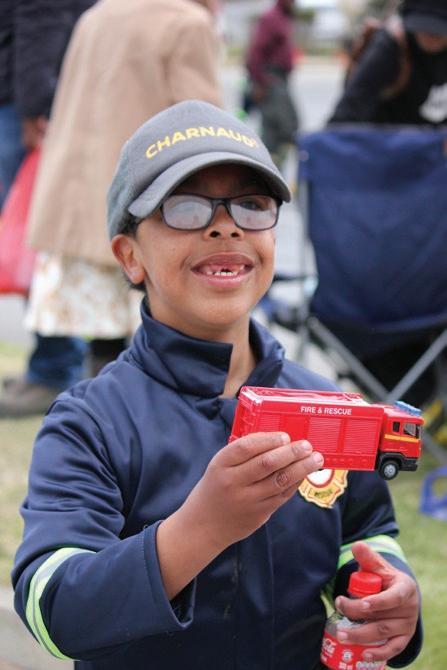

I am still overwhelmed by the reaction of most of the participants and organisers. I take part in the event because I believe in “leading by example” and not only to be rewarded. According to me I did not do the best I could, I nearly mist this event due to an old back injury and I’m glad that I didn’t withdraw. Despite all of this, everyone told me that I am an inspiration to them. I would really like to thank the organisers and everyone else that helped to make a great success of TFA 2022; without your effort the event would not be the same!!! Thanks again.
Dale Alexander, fire fighter, City of Cape Town Fire and Rescue Service
It was my first time competing in the TFA. I loved the comradery and I got to experience with work colleagues I hadn’t met before in the fire service and had a sense of common goal. It felt amazing to win my age category (30 to 34), came third overall and secured the trophy for best newcomer. I am already looking forward to the next one. A special thanks to the organisers for providing such a wellrun competition. Lastly and most importantly, a big thanks to my two close teammates Tristan Nayman and Baigum Abrahams for keeping me and each other accountable through the difficult tedious training sessions. See you soon TFA 2023.
Lesego Molikwe, Team N’zuri (West Rand)
For me it was a test that stood the test of the tough....but key was not to be shaken, it will always be a memory for me and my team: winner of Best New Entrant Female (second overall).
Ontiretse Puleb, Team N’zuri (West Rand)

For me the competition was a wonderful experience that I will forever cherish. Giving it my best was not enough, I gave it my all. Winner of 45 to 49 group and third overall.
Samson
N’zuri (West Rand) team captain
For the competition was so exciting and wonderful. I have learned that working together as a team full effort brings excellent results, believing in the Almighty in everything is the best move that one can choose to follow and as fire fighters we don’t stop because we tired, we stop because we’re done. Ready or not when the bell rings, someone must respond.
Bongiwe Kubeka, Team Nzuri (West Rand)
Thank you for the opportunity of being part of TFA competition. I wouldn’t have made it without the support of my coach, Mr Manie Gouws and my team, Nzuri. I am very grateful for the support they gave me. I feel overwhelmed and emotional and I am at a loss for words, this is a very special moment in my life. It already felt like a win when I found out that I am part of the TFA competition. I am looking forward to the next year’s competition because now I know what to expect, thank you!
Siphosethu Mataka, uMgungundlovu District Municipality
I came second in 40 to 44 years’ category and a newbie but had a great experience and for my first time I did my personal best.
8 | FIRE AND RESCUE INTERNATIONAL Volume 6 | No 6
Mokemane,Team
Toughest Fire Fighter Alive South Africa
Back to Contents
Future fire fighters in the making! Future fire fighters in the making! Future fire fighters in the making!
The atmosphere was great, the support, the camaraderie that other fire fighters and the spectators were, was out of this world. Hoping next year would be more fun and thanks to Mossel Bay Municipality and family, see you next year.
Laeza Mokoena
The competition was very tough, however, it has taught me to “never say never” in life and am so proud of myself that am at the top three.
Gerard Lundall, Fire Fighter 3, Chief Dawid Stuurman International, Airports Company South Africa (ACSA)
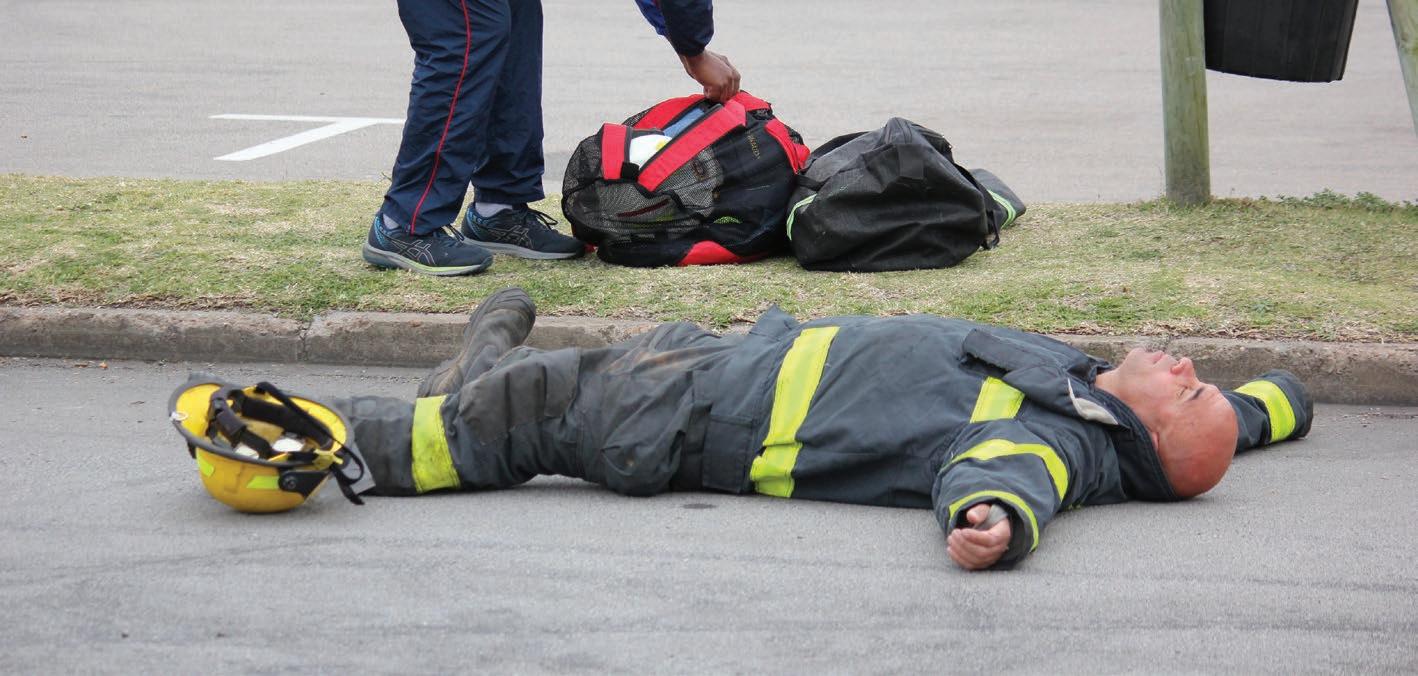
I was the organiser for our team and partly responsible for us making it to TFA 2022. We were newbies at TFA 2022. Our experience at the event was truly enlightening and magnificent at the same time. Our guys out did themselves and we even managed to achieve a second place age category placement and sixth place in the relay event...well done to us!
TFA will be seeing a lot more of the ARFF guys in the future.
Christo Theron, operational director, Firstcare Wildfire Support
On behalf of the Firstcare Wildfire Support team I want to thank Mark and his team for presenting an
awesome event. To each and every fire fighter that took part, you are all winners. Thank you for the new friendships made, we will cherish this weekend always. Also a big thank you to Chief Johnson and his team from Mossel Bay Fire and Rescue for your hospitality and hard work that went into this event. As wildland fire fighters, this was an eye opener for our crews and they enjoyed every minute of it. And even though we are just a volunteer organisation, we were welcomed with open arms.
Johannes Selogiloe, JB Marks Municipality
My experience was that even if things are hard and tough, you must never quit in life in whatever you are doing and being at the TFA, it matters not if you are a newbie or not, it needs stamina and endurance and I have realised that I must put in more effort on my fitness.
Mamzo Moswete
The mountain feels a little too high to climb but is climbable.
Smanga Kamase
I won Gold on relay out team name The Legend. And I won Silver on 50 to 54 age category. It was very challenging, extremely difficult and exhausting but what a great experience.
Gift Malejwe, N’zuri Team, West Rand
It was great to see how all gave some and some gave it their all. Winning the men’s relay for the second time really shows that greatness demands commitment. The key is to enjoy it, after all pain is temporary but pride is permanent. I can’t wait for the next one already.
Vincent Naudé
For a first timer at TFA it was way beyond what I expected but having a first time experience in light and functional Charnaud fire gear, was well worth the blood sweat and tears. But what a great and humbling experience that I got to share this with a great bunch of brothers and sisters who all share the same love and passion!
Fire and Rescue International magazine is proud to be the official media partner to Toughest Fire Fighter Alive South Africa.
Congratulations to all participants and a very big thank you to all the sponsors, exhibitors and volunteers for their tireless input and support of TFA SA 2022. The TFA will be returning to Mossel Bay in 2023 and 2024.
View the full TFA 2022 gallery on the TFA 2022 website
View the TFA 2022 YouTube playlist

FIRE AND RESCUE INTERNATIONAL | 9 Volume 6 | No 6
Toughest Fire Fighter Alive South Africa Back to Contents
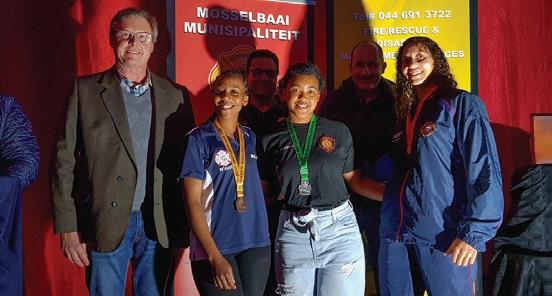
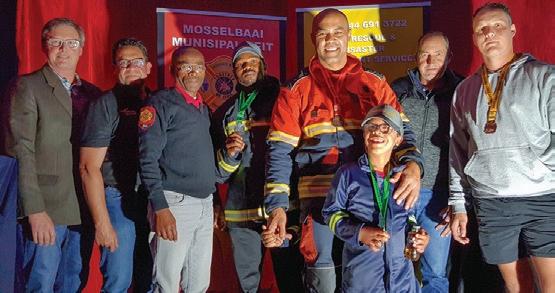

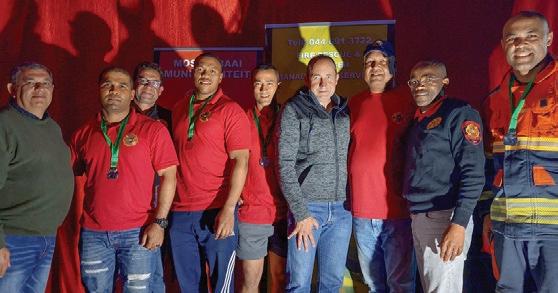

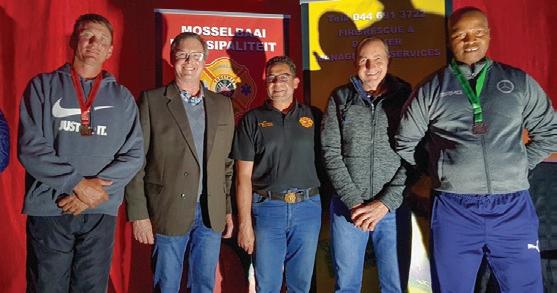
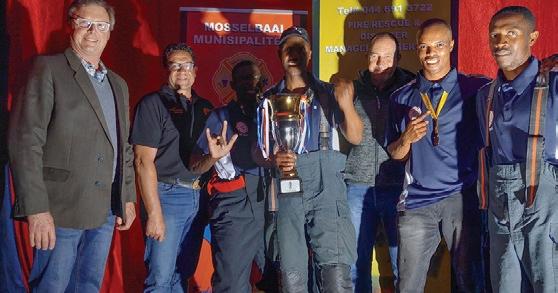
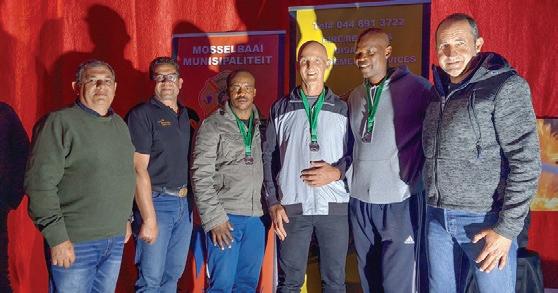

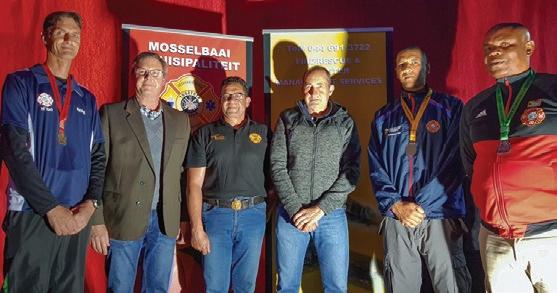

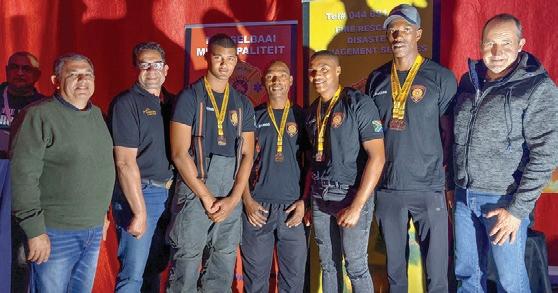



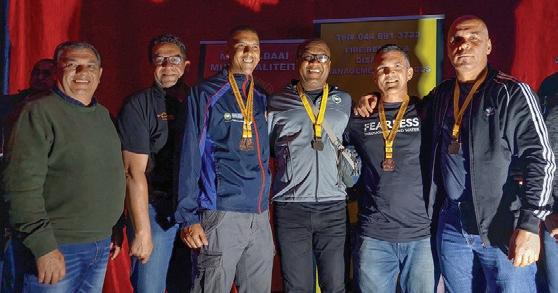



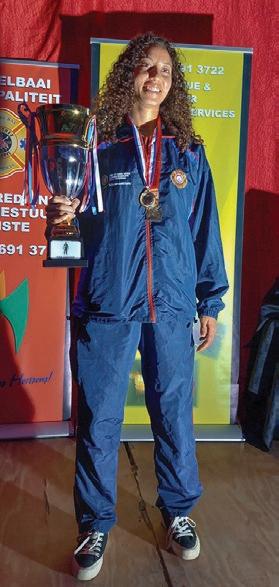
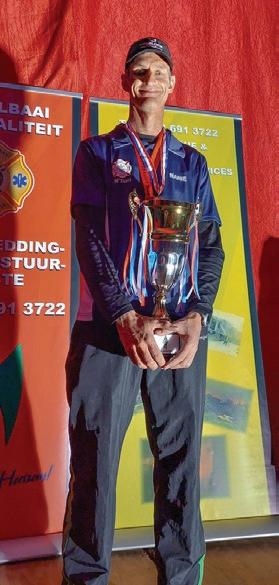
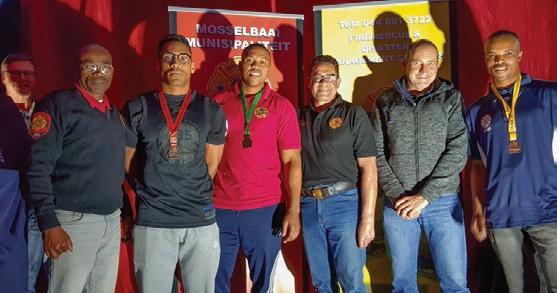

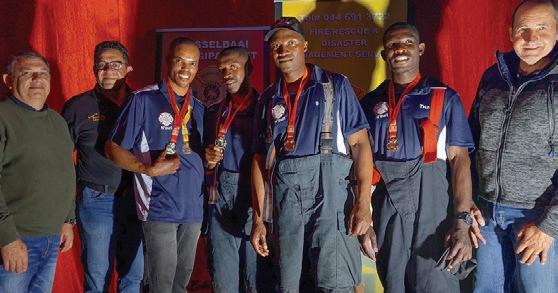
Volume 6 | No 6 10
Nelson Mandela University holds
13th Fire Management Symposium at its George Campus
The Nelson Mandela University (NMU) George Campus held its 13th Fire Management Symposium on 23 to 25 November 2022 at its George Campus on the Garden Route. The symposium consisted of a two day conference as well as a field day to three separate venues with 24 presenters sharing their knowledge, research, data and experience.

The theme of the symposium was ‘Preparing for the next mega/disastrous fire’. The main purpose of the event was to share information and compare notes between veldfire scientists, wildland fire managers and fire authorities that would indicate what have been done to offset unwanted, destructive wildland fires and to identify shortfalls in the preparation to face the next fire disaster.
Session One was chaired by NMU’s Prof Jos Louw with a warm welcome from Tiaan Pool followed by the official opening by Dr Kaluke Mawila, campus principal at the NMU George Campus, who provided an overview of the NMU George Campus’ Veldfire Management curriculum and its global networks.
Prof Peter Fulé of the School of Forestry in Northern Arizona University in the US provided the key note address, which was themed ‘The missing link between research inputs and technical outputs’. Prof Fulé explained how integrated fire management (IFM) can be defined as the prevention of unwanted veldfires, protection of assets, human lives and the environment, suppression of unwanted veldfires, research and rehabilitation of areas affected by veldfires. The missing
link in integrated fire management is a breakdown in communication between all role players, not using all available resources, including the human resource within the community, as well as failure to cross boundaries between management and research. IFM should take place on all spheres of state ie national, provincial and local. If the political will and support in any of these spheres are absent or poor, the potential of IFM will be limited. “How can we address the “missing link between research inputs and technical outputs”? The big picture issues remain essential and two-way communication is vital. In my view, the mobilisation of all our diverse resources ie human, disciplinary and technological, helps contribute to engaged, adaptive stewardship of the Earth and more equitable societies.”
Greg Forsyth of the CSIR, now retired, discussed the current and future veldfire risk in the world and South Africa. In his presentation Forsyth provided insight into wildfires worldwide, the drivers of wildfires, recent wildfire events ie Europe, USA, Australia and South Africa, the fire paradox where stringent fire suppression policies are based on the belief that that fire can be totally excluded from any particular area, which in practice is not feasible nor ecologically desirable (Calkin et al. 2014), fire dependant ecosystems, wildfire risk and the usefulness of wildfire risk assessments. Forsyth said that the fire problem is increasing worldwide due to global weather changes and also because of poor land management. And that climate change is contributing to the problem. “A balance is needed between maintaining fire regimes and ensuring human safety but expanding
FIRE AND RESCUE INTERNATIONAL | 11 Volume 6 | No 6 Wildfires: 13th Fire Management Symposium
Back to Contents
development, especially in the WIU, is complicating fire management”, said Forsyth.
Lee Raath-Brownie of Fire and Rescue International shared insights on the role and impact of the media on fire management in South Africa. She provided background information on a recent study done showing the differences in media impact of stories with and without the voice of scientists, highlighting the importance of the narrative given to the media during and after incidents. She also shared the importance of appointing a public information officer (PIO) as per the Incident Command System (ICS) and described the PIO dos and don’ts. Raath-Brownie shared the eight step communications model as per the ICS, which was sourced from Dynamic Incident Management. “Social media is a very powerful tool for PIOs. Know your media/ journalists, both local and national and keep the narrative simple (KISS)”, said Raath-Brownie.
Dr Izak Smit, senior scientist at SANParks continued the discussion around the media with his ‘Fire as friend or foe: the role of scientists in balancing media coverage of fires in National Parks, siting his recent research project also mentioned in Raath-Brownie’s presentation. Dr Smit said that the media influence attitudes and hence actions and expectations towards fire management, sharing his recent research and statistics on media headlines. He said that the research identified three biases and that the first bias focusses on the negative effects of fire and the second bias

showed basic fire ecology concepts lacking with the third bias on reactive fire management as opposed to proactive fire management. “Media can be an important partner in educating society to have a more systemic understanding of fire. Both fire management practitioners and fire ecologists/scientists have a role to play a role to inform a nuanced narrative around fires”, said Dr Smit. Fire managers are missing an opportunity to educate the man in the street and fail to prevent fireanxious communities by not planning the messages that go out to the media.
Arno Pienaar of Montigny Investments/Bastion Security shared the Swaziland experience in his presentation ‘An alternative (military) approach to fire management’ and also making a statement about traditional insurance versus the security brought about by a unique fire management system. Pienaar said that their key to success is military appreciation, intelligence, staff selection and training, community relations and control with military appreciation determining a clear objective, identifying all elements of the situation and terrain and analysing and measuring each element of overall strategy, detection, reaction, suppression, command and control at the fire and in control room and mop up and patrols. Intelligence focusses on arson fires and the FDI with statistics providing the number of arson fires per district, day of the month, day of the week, time of day and phases of the moon. Pienaar highlighted the importance of building relationships with the community and staff selection and training. “To lead people is a science’, said Pienaar.
12 | FIRE AND RESCUE INTERNATIONAL Volume 6 | No 6 Wildfires: 13th Fire Management Symposium
Back to Contents
Prof Andrea Thode of the School of Forestry at Northern Arizona University in the US, who discussed ‘Shifting the paradigms in wildfire training and education. Prof Thode shared the background and working of the Association for Fire Ecology (AFE), which was founded in 2020 and is an international organisation dedicated to improving the knowledge and use of fire in land management. She also included the Student Association for Fire Ecology (SAFE), the Wildland Fire Professional Certifications and the certifications programme. Prof Thode shared information on the North Arizona University (NAU) School of Forestry’s Undergraduate Fire Ecology and Management Certificate and the Wildland Fire Education and Training Collaborative, which is based out of NAU to provide and connect fire science educators, trainers and the public with scientifically solid and peer-reviewed teaching tools and techniques, using state-of-the-art materials, which is free and accessible to all. She added that the World of Wildland Fire is a movable textbook of videos for use in trainings and education.
Session Two was chaired by NMU’s Dr Muedanyi Ramantswana and started off with Trevor Abrahams of Working on Fire, whose presentation focused on ‘Wildland fires and climate change: emerging trends, challenges and imperatives. Abrahams provided an overview of the Working on Fire (WoF) programme and objectives, saying that the EPWP Programme had grown from 850 in 2003 to 5 300 members in 2022. Abrahams also provided an over view of WoF Aviation, Training Academy and Fleet Management. He discussed Global Wildland Fire Management, the recently held IAWF Fire and Climate Conference in Pasadena in the USA and climate change and wildfires in South Africa. “The imperatives for South Africa is to address wildland fire management capacity through trained fire fighters, aerial fire fighting capacity, fire protection (FPA) capacity, the uniform implementation of ICS and refresher training and better integration between fire brigade services and wildland fire management services. We need to focus on focus on prevention, better use of weather forecasting in integrated fire management (IFM) and increase applied wildland fire management research” said Abrahams.
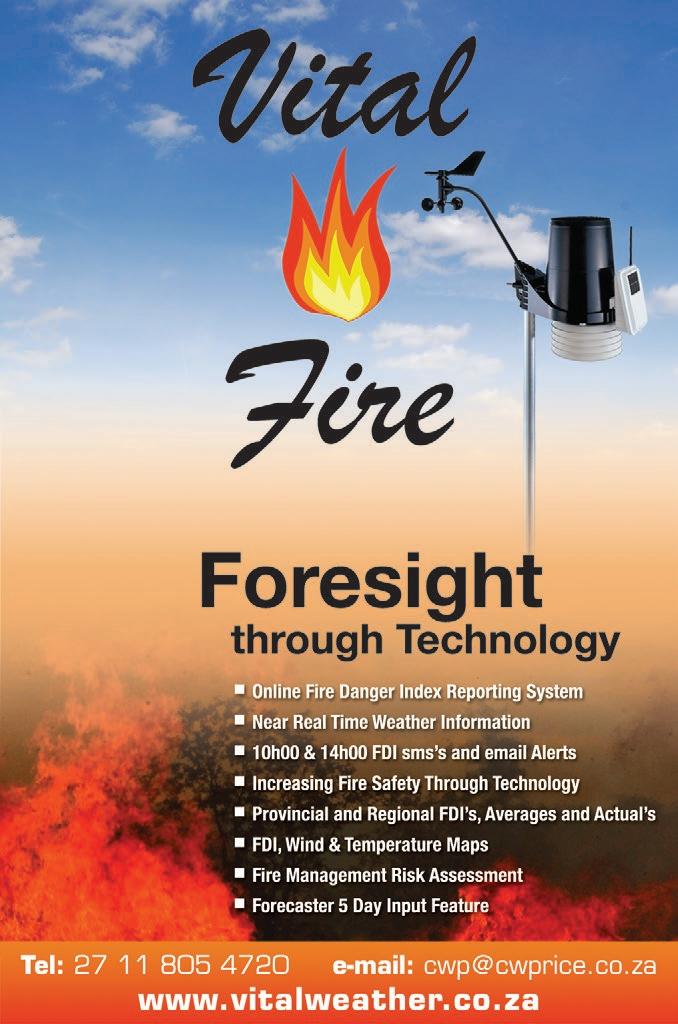
A presentation by Ian Pienaar of Montigny Investments in Swaziland followed that shared their information on the use of sniffer dogs to catch arsonists. Pienaar discussed the role of K9 teams in the fight against arson fires saying, “A well trained K9 team will have a massive impact on fires and crime in your area. It must be a team dedicated for this purpose only and the ongoing training program and operations must be controlled in detail and constantly to ensure the outcomes required.” He also shared why this K9 programme is so successful, as the handlers and K9s are highly trained. This team is dedicated to do this job only and can’t be doing other work as the training of these dogs never stops. Every aspect of training and operations is controlled in detail to ensure that the quality stays high and the outcomes are reached.

Laura
discussed ‘Planning-based bushfire risk assessment by translating risk into land use planning practice. Gannon discussed the cross-dimensional challenges, integrated approaches, the value of land use planning in hazard risk management, dealing with fire risk, shared some case studies and detailed land use planning tools. “Ultimately we need multi-disciplinary and multi-jurisdictional collaboration, a balance between evidence-based decision making and the precautionary principle, holistic and sustainable landscape
FIRE AND RESCUE INTERNATIONAL | 13 Volume 6 | No 6 Wildfires: 13th Fire Management Symposium
Gannon of Meridian Urban Brisbane
Back to Contents
The Working on Fire Team
stewardship, improved linkages with research, transport planning, emergency management processes, building regulations, transitioning hazard and risk to frontend of planning considerations and ensuring climate projections are factored in”, said Gannon.

Paul Gerber of the Department of Forestry, Fisheries and the Environment, shared ‘The responsibility of fire protection associations (FPAs) to prepare communities for mega fires. “Veldfires are a matter of common concern. For this reason, in South Africa as in other countries, effective policies and plans for preventing and combating veldfires, must be clear about individual responsibility as well and cooperative and coordinated roles and responsibilities”, said Gerber. He shared the impact of the Knysna fires and detailed the strategic objectives identified by the Vulcan workshop to be implemented by all role players and highlighted what we cannot change such as climate change and the key issues to be addressed to prevent mega fires through coordination and cooperation. Gerber mentioned funding and the effective fire management integration by FPAs, with the main focus on prevention. “What we can manage is prevention and our fuelloads”, said Gerber.
Pam Booth, environmental manager in Knysna detailed the eco-friendly fireproof buildings that were constructed recently. Houses that are built in the urban interface areas ie where the urban area and natural areas meet, are at risk of burning down when there are mega fires. These houses must be designed to be fire resilient and the use of fireproof building material for construction should be promoted.
The Friday’s first session was chaired by NMU’s Dr Tatenda Mapeto and featured a key note address by Working on Fire’s Piet van der Merwe, who discussed preparing for the next disaster fire. “Integrated fire management (IFM) refers to a systematic, holistic approach to managing wildfires and includes five elements, also referred to the five Rs ie reduction (aligned to prevention), readiness (protection and preparedness), response (strategies and tactics to suppress a fire) recovery (lessons learnt and rehabilitation of damage) and research (data collection and analyses to solve wildfire challenges). Working on Fire (WoF) has developed the IFM wheel encompassing the five elements.” He concluded, “Preparing for a disaster fire should be an IFM approach by all stakeholders. Individual landowners may have some or all of the IFM elements in play but they cannot be as strong on their own as when they collaboration with their neighbours, between FPAs and other organisations. Fires don’t respect cadastral boundaries and IFM shouldn’t either. Wildfire is a science and IFM should have a sound scientific base for effective and practical management.”
This was followed by Val Charlton of Land Works, who shared the results of the survey done on fire protection association readiness. The recommendations Charlton shared included that Umbrella FPAs need to be well resourced, for the public good and their performance managed by the Advisory Forum, which can play a critical independent role. There should be a focussed (pressurised) intervention to get state landusers to become members. Revisit the independent Advisory Forum’s strategic role in South Africa. Develop a five year funding partnership with key private sector stakeholders to develop a convincing value proposition for membership at local, provincial, national level. Influence communication and practices to align to biodiversity stewardship, disaster risk reduction, climate adaptation and thus play to Government’s priorities. Develop and maintain a comprehensive and information-rich website for the Advisory Forum to service landusers, FPAs, public etc.
The Western Cape Government’s Etienne du Toit provided insight, with some strong questions asked, on preparing a metropole for the next mega fire. Du Toit said, “A cohesive wildfire management strategy rests on three pillars: creating fire-adapted and resilient landscapes; building fire-adapted human communities and a safe and effective wildfire response. The circle rests on the jurisdictional cycle of cooperation and collaboration among local, provincial and national

14 | FIRE AND RESCUE INTERNATIONAL Volume 6 | No 6
Wildfires: 13th Fire Management Symposium
The DFFE and Southern Cape FPA team
Back to Contents
The Eastern Cape FPA team
entities and their affiliates.” Du Toit discussed the current realities of mega fires, saying, “We cannot suppress megafires, we simply manage the consequences. Be prepared for the worst. Be prepared to lose multiple structures, blocks and suburbs. Not all properties can or will be saved. Acknowledging that you have a risk is the first step. People tend to think of WUI fires as a forest health problem or a fire department problem and it really is a community problem.” He also detailed the wildland urban interface and strategy saying, “The most effective form of structure defence is to suppress the wildland fire. Perimeter control must be the number one operational priority utilising established wildland fire fighting tactics to suppress the fire before it reaches structures. The key to success in the wildland urban interface is preparation and pre-incident planning.”
Mondi South Africa’s Deon Greyling, shared information on whether commercial forestry companies are ready for the next mega fire. Greyling shared the five pillars underpinning the Mondi fire strategy: fire prevention, fire protection or state of physical readiness, fire suppression, fire investigation and community and contractor relations adding that fuelload influences all five pillars. He detailed each and shared Mondi’s fire suppression achievements, saying that the international benchmark was surpassed in nearly all respects. He showcased their significant safety and ergonomic interventions ie vehicle protection, bakkie sakkies, auto reels and bumper turrets and thermal curtains and the introduction of double cab tenders, designed around small crew size of four to five. Mondi also invested in compressed air foam systems (CAF) technology to ensure faster fire suppression and excellent postextinguishment protection, which exceeded their expectations. Other technology includes the use of mechanised mop-up thermal cameras and remotely piloted aircraft system (RPAS). Greyling concluded, “If you are always ready, you don’t have to get ready!”
A presentation by Dr Rachel Loehman, a research landscape ecologist at the US Geological Survey, Alaska Science Centre on ‘Fuel modelling - a basis for fuel management intervention, followed. Dr Loehman explained what are wildland fuels, saying that fuels are the most important environmental factor in fire management and that fuels determine fire effects. She added that it is important to measure fuel properties in order to predict and manage fire behaviour and effects. She explained the visual fuels estimation method ie photoload and LiDar. She also discussed the emerging issues surrounding fuels, fire and fynbos, adding that the paths forward include fuels and fire behaviour characterisation, empirical fire effects studies and predictive modelling with monitoring.
CapeNature’s Dr AnneLise Schutte-Vlok discussed prescribed burning, the right option in Fynbos? Dr Schutte-Vlok said that the fire season and intensity usually go hand in hand ie quick hot fires versus slow, cool ones. “Retaining the biodiversity in an ecologically healthy state will result in a sustained flow of high quantity and quality water”, she added. Soil-stored seed from large-seeded ant- and rodent-dispersed species eg Mimetes, Leucospermum spp. need hot, intense, clean fires while low-intensity fires favour small-seeded, often weedy pioneer species eg Helichrysum, Stoebe spp. and Kystervaring (Gleichenia). Repeated low-intensity fires result in increase in these spp. which will increase flammability of the veld at early age due to large loads of fine materials. The veld ignites more easily resulting in shorter fire return interval and loss of slow-maturing species. Dr Schutte-Vlok said that the fire management plan must identify areas of concern and clear aliens, include awareness raising campaigns, ensure firebreaks are in place and restrict developments in fireprone areas.
Sappi Southern Africa’s Jeffrey le Roux shared the effect of veldfires on the small and medium timber growers. Small

FIRE AND RESCUE INTERNATIONAL | 15 Volume 6 | No 6
Wildfires: 13th Fire Management Symposium
Back to Contents
An evening spent with industry friends
growers comprises of 3,8 percent of the forestry industry, while medium growers has 14,6 percent of the forestry area. Le Roux said that a mega fire needs to only be a hectare to have severe impact on someone’s livelihood; the impact of fire is dire for small and medium growers. Medium growers are better placed currently as opposed to small growers. We need to prepare for the bad day that we know is coming. “Ensure that the basic principals of fire prevention and preparation are practiced to mitigate fire damage as much as possible. Responsibility ultimately lies with the landowner. Sustainability of current and emerging small and medium growers is going to be very reliant on continued support from more experienced role players within the industry”, said Le Roux.

A joint presentation by EnviroVision Solutions (EVS) Systems’ Dr Gavin Hough and FireWeb’s Noel Harrison followed, who discussed how the integration of early detection and rapid response can mitigate the risk of mega/disastrous fires. Dr Hough described how the EVS fire detection camera system works and its benefits. He also explained the ForestWatch Mobile App and its features which include finding fires, new fire notifications, weather and FDI/FDR forecast, views from the cameras, GeoSpatial and satellite overlays and FireWeb integration. FireWeb’s Harrison then detailed the hand over from early warning systems into the rapid response or initial attack component and post incident analysis. “Most organisations we have worked with produce an annual operational plan and we looked at how we could incorporate the plan into tools suitable for
initial attack users. The tool we developed to support this allowed users to define the weighted response in terms of resource, either by type or specific unit, personnel by role and qualification as well as we enabled the ability to setup varied rules based on regions or geography”, said Harrison. “All information can be linked to the incident report and can be used for analysis purposes post incident. We have worked heavily with industry to define standard reporting templates and options to ensure we align our information gathering efforts”, he said.
The second session on Friday was chaired by NMU’s Barry Muller with Dr Jo Barnes who discussed the pollution of ground water from fires and fire suppression. Mega fires have a devastating effect on groundwater as fire changes the composition of vegetation as well as soil vulnerability of the landscape. Natural vegetation is often replaced by invader species that use more water. Dr Barnes said that groundwater and fires are like a two-way street: The state of groundwater affects risk and the extent of wildfires and wildfires have serious effects on the state of the environment, including groundwater. Dr Barnes highlighted the importance of groundwater adding that two-thirds of South Africans rely on groundwater as their primary source of water. It is not only used for drinking and sanitation but also to support livelihoods, agriculture, ecosystem health and industrial growth. “Research has shown that when a wildfire occurs during a hydrological drought, almost 10 times more land is burnt than during a non-drought year.”
16 | FIRE AND RESCUE INTERNATIONAL Volume 6 | No 6 Wildfires: 13th Fire Management Symposium
Back to Contents
The Southern Cape FPA’s field day
Prof Keith Little, who shared research information on pelargonic acid as a replacement for paraquat for the preparation of firebreak tracer-lines. “Paraquat is a robust chemical with consistent performance over a range of vegetation types. The rate of application with pelargonic acid is important and the vegetation type and cover has an influence on desiccation. It is able to burn and a suitable alternative to paraquat”, said Dr Little.
Avelile Cishe, an NMU postgraduate student discussed alternative fuel management methods in South Africa. “Fuelload management is the best insurance in wildfire management and fuel availability contributes to fire behaviour”, said Cishe. He shared some fuelload management techniques and fuelload reduction selection criteria. “Integrated fire (fuel) management is key and should form part of the climate adaptation and mitigation strategy. More research needs to be done on various fuelload management techniques”, he said. “The integration between research outputs and technical application is critical”, concluded Cishe.


Angel Goldsmith, a PhD candidate in Geography Research at Leverhulme Centre for Wildfires Environment and Society, King’s College in London, discussed the missing link in wildfire emergency management in South Africa: early warnings and information dissemination. His research includes to identify communication gaps and lessons from recent mega fires, to review communication research and international practice in wildfire risk communication and to propose a framework to improve fire risk communication and resilience for South Africa. He cited some of the international best practices, the four conceptual models of risk communication, fire risk communication typology in order to improve theories guiding the design of fire risk communication strategies and to better inform the community of emergency evacuation procedures.

NMU’s Hannes van Zyl provided an overview of the Friday’s sessions and Tiaan thanked all the participants, exhibitors, presenters and delegates for their support.
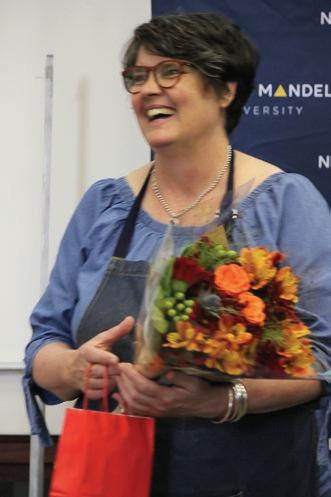
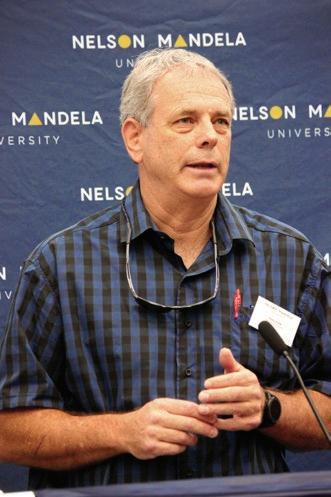
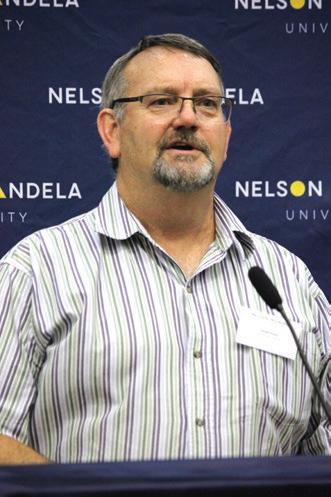
The field day trips included a visit to Pinnacle Point, an archaeology site occupied by Middle Stone Age people between 170 000 and 40 000 years ago and the Dias Museum in Mosselbay; a visit to Prins Albert via the Swartberg Pass, a pristine Fynbos landscape and the Southern Cape Fire Protection Association’s field day, with visits to the EVS camera system, BioChar, activated charcoal research and some site visits of the Knysna burn scars and rehabilitation.


FIRE AND RESCUE INTERNATIONAL | 17 Volume 6 | No 6 Wildfires: 13th Fire Management Symposium
View the full photo gallery
Lunch time!
Unique gifts for the presenters
Back to Contents
Dr Kaluke Mawila Prof Jos Louw Tiaan Pool Hannes van Zyl Sonia Roets
JOIFF Africa Conference 2022
The JOIFF Africa Conference 2022 took place at the Emperors Palace Conference Centre in Johannesburg, South Africa on 14 and 15 November 2022. The event, which attracted both municipal as well as specialist industrial and petrochemical fire service chiefs, leaders and representatives, provided

attendees with technical insight, research projects and results as well as practical advice in dealing with any size scenarios as well as daily risks faced by these sectors.
Some members of the JOIFF Board of Directors also attended the event including Alec Feldman and Gerry Johnson. There were several exhibitors displaying their products and services in the networking hall including the platinum sponsor, the Advanced Group of companies, Bristol Fire Engineering, DoseTech Fire, Dräger, Dr Sthamer, Emergency Training Solutions (ETS), Fidelity Fire Solutions, Fire Raiders, Fomtech and Unqondo Projects, Marcé and Hytrans Fire Systems and Vanguard Fire and Safety.
JOIFF chairperson, Pine Pienaar, welcomed all and provided background information on JOIFF, the International Organisation for Industrial and Petrochemical Emergency Services Management and its membership benefits.
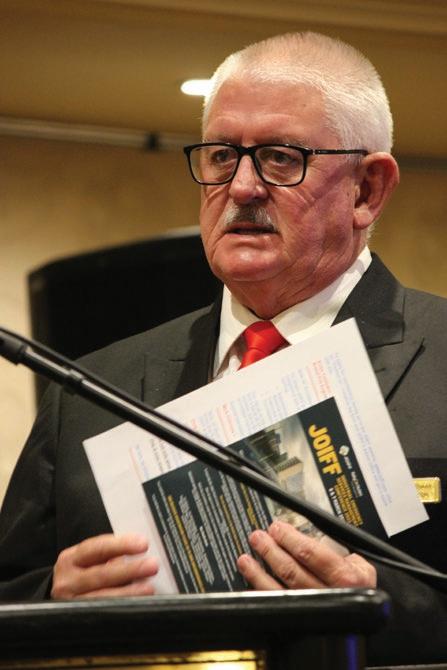
Session one of the JOIFF Africa Conference 2022 focussed on
disaster management during large scale incidents and included a presentation on ‘Understanding evacuation modelling and human behaviour’ by Stellenbosch University’s Dr Natalia Flores Quiroz, which factors that influence evacuation, human behaviour in fire and computational evacuation modelling. Dr Quiroz said that large scale evacuations due to fire events are becoming more and more common and present challenges such as not having enough exit routes and lack of information on when, where and how to evacuate. “Understanding human behaviour in fire is critical for improving fire safety. Computational modelling can be very useful to understand evacuation in complex buildings or complex situations”, said Dr Quiroz. She also detailed the factors that influence fire evacuations and the various computational modelling techniques, which include movement, behaviour and environment.
Western Cape Disaster Management and Fire and Rescue Services Colin Deiner, spoke about ‘Flooding in
18 | FIRE AND RESCUE INTERNATIONAL Volume 6 | No 6 JOIFF Africa Conference 2022
JOIFF chairperson Pine Pienaar and directors Alec Feldman and Gerry Johnson together with speakers and attendees at the JOIFF Africa Conference 2022
Back to Contents
JOIFF chairperson, Pine Pienaar
Kwa-Zulu Natal - lessons to be learned’. Deiner provided statistics on the impact of Tropical Storm Issa that hit KwaZulu-Natal in April 2022. He detailed the Western Cape’s search and rescue (SAR) capacity and its response, deployment and operational assistance, saying that it was positive to note that various agencies all came together with aerial support from the SANDF and South African Police Service (SAPS. Deiner also discussed the incident command, which was the responsibility of the SAPS, the SARZA joint operations command (JOC) and the coordination by the Kwa-Zulu Natal Provincial Disaster Management Centre (PDMC), with engineering assistance, the PDMC JOC/Provincial JOC, National Interministerial Committee on Disaster Management (ICDM), NJFCC/NDMC and cluster response. He shared key observations, saying that rapid response to early warning systems is essential, South African response teams need to refocus on regional risks, clear incident command must be established early, no political interference and safety is always the top priority. He also thanked the various agencies and volunteers that responded for their support including SARZA and National Sea Rescue Institute.
Ian Scher of Rescue South Africa discussed large scale disaster rescue, providing background on the formation and history of Rescue South Africa, saying that its primary objectives are to respond to sudden onset disasters and provide technical rescue skills, to build a cache of equipment to be used for both training purposes and response and to build capacity by offering rescue training, regionally, nationally and internationally. Scher said that they approached USAID for funding and eight American rescue technicians came to South Africa, qualifying 26 trainers. He also detailed its cache and how it is utilised and maintained with videos of a walk through the warehouse, describing the various equipment categories as well as its radio communications equipment. Scher discussed Rescue South Africa’s training model, sharing
a video on recent training events and concluded with videos on their recent disaster response missions, announcing the addition of the new diving crew in Durban.
Session two focussed on foam technology and LASTFire’s Dr Niall Ramsden provided an update on NFPA 11 with test results on new generation foam concentrates. He also discussed the fluorine free foam issue and shared updates from European Chemicals Agency (ECHA), the NFPA/EN, LASTFire research network and the Arctic Council. Dr Ramsden said that the ECHA Annex XV Restriction Report was good summary and a genuine attempt to be practical and understand the risk, adding that Risk = Probability x Consequences. He also detailed the PFAS-containing fire fighting foams management plan. Dr Ramsden discussed the NFPA 11 Standard for low, medium and high expansion foam, saying that greater clarification is needed especially for tank fires, losses due to wind and compressed air foam (CAF) systems. He shared recent LASTFire research, test protocols, results and videos. He also shared the test results of their crude oil testing in the five-metre diameter test tank with different application techniques, nozzles, foams and proportioning rates. Dr Ramsden shared information on the large scale polar solvent test fires and the phasing out of AFFF in the Arctic.

Williams Fire and Hazard Control’s Dean Roux set the scene for fixed fire reticulation systems versus mobile response systems discussing the benefits, challenges and shared learnings of each application. Roux described the mobile response components, fixed system components, benefits, performance components and challenges such as what happened during the Buncefield incident in December 2005. He also shared various case histories and explained the challenges faced from mobile response. Describing their ongoing developments in strategic tactical fire planning and logistics, Roux described that monitor water strainers were inbuilt to the waterway and through-monitormanifolds allowing multiple monitors connected for crude oil applications and post suppression. Roux added the use of aerial drone usage and incident command during multi-agency responses.
Tetra Tech’s Dr Ian Ross, detailed the ‘Transition from older generation foam concentrates to new generation foam concentrates - not merely a matter of take out and replace’. Dr Ross provided an overview and the characteristics of Per- and Polyfluoroalkyl substances (PFAS) as well as PFOS and PFOA and its precursors, looking at its toxicity levels in human exposure, blood and its environmental footprint. He shared global media reports
FIRE AND RESCUE INTERNATIONAL | 19 Volume 6 | No 6 JOIFF Africa Conference 2022
Back to Contents
JOIFF director Gerry Johnson, JOIFF chairperson, Pine Pienaar with JOIFF director Alec Feldman
and said that fluorine free foams perform comparably to C6 foams, sharing the relevant fire suppression systems. “Effective decontamination is required for successful foam transition,” said Dr Ross, explaining the triple swabbing method.
Session three focussed on managing emergency responders with Dr Rina Steynberg discussing ‘Total wellness of emergency responders’ and shared the role of resilience in total wellness, saying that resilience is the inner strength of body-mind that enables one to respond well to adversity. “It is the capacity to prevent stress related conditions ie anxiety, depression, illness, recover faster and more completely, optimise total functioning ie mental, emotional and physical or in other words, the ability to bounce back. She described the resilience model: the trigger, response, resources and result, detailing each and explained short versus long term stress. She concluded with constructive leadership and culture, detailing the basic needs of a team.
Mike Perry of Africa Reptile and Venom shared ‘Identification, safe handling and treatment in event of snake bite incidents by emergency responders’. Perry shared the history of antivenom in South Africa, its manufacturing and extraction, freeze drying process, adding that horses are used as antibody factories and the

use of hyperimmune horse blood. He detailed the main African snakebite culprits, the common facts about snakes, saying that there are about 170 species and sub-species of snakes in southern Africa with around 10 percent of those considered dangerous to man. He listed the most dangerous snakes and the signs, symptoms and result of their bites.
Dr Nigel Blumire of CTIF shared information on the Hydrogen economy and its future challenges for responders. Dr Blumire provided the background on the National Chemical Emergency Centre (NCEC), which was established in 1973, set up by the UK Government to provide emergency response support to
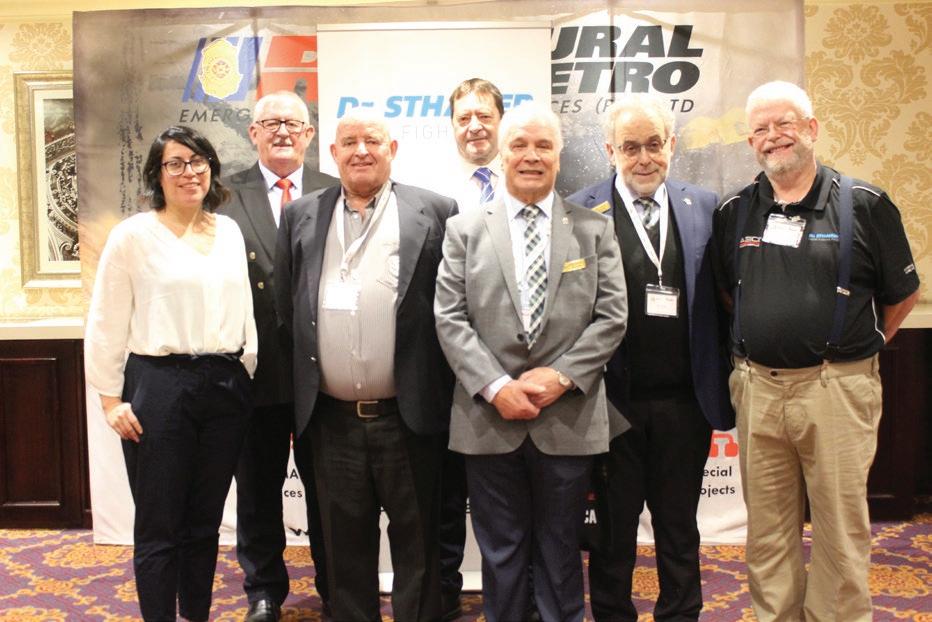
incidents involving hazardous chemicals. He shared details regarding several hazmat incidents including the Hydrogen explosion on 8 January 2007 at the Muskingum River power plant, when a rupture disc failure caused the explosion. Dr Blumire discussed Hydrogen, saying that the flame has no colour and can’t be seen during daytime but can be detected via ultrasonic sound detection. He also looked at the future of Hydrogen, its production, density and flammability and the issues arising when confined, adding that its ideal storage temperature is minus 253 degrees Celsius. He shared some case studies and its comparison with various other fuels such as natural gas and petrol.
Session four saw Stellenbosch University’s Prof Dr Richard Walls discussing structural fire engineering for industrial buildings, sharing who is responsible for structural fire resistance looking at SANS 10400-A Form 4, SANS 10160-1 SANS 10400T and SANS 10177-2, understanding structural design and load paths, how fire affects structures, satisfying fire resistance and sharing several case studies. Dr Walls also looked at the effects of fire on concrete and timber as well as composite deck design, saying, “All structures require the fire resistance to be checked. Structural engineers should do this to SANS 10160, although it is typically not done. Most structural engineers in South Africa currently have very
20 | FIRE AND RESCUE INTERNATIONAL Volume 6 | No 6 JOIFF Africa Conference 2022
Conference presenters
Back to Contents
Conference presenters
little knowledge about fire design.” He added that fire resistance can be verified using relatively simple methods and that good design can save a lot of money in passive protection. He concluded in saying, “Real collapse comes from restrained thermal expansion rather than material getting weak. If your team gets killed it will be from a connection failing rather than anything else. There are many emerging construction systems that are not fully understood and their fire resistance must be carefully considered.”
FireDos’ Frank Preiss’ presentation focussed on the importance of accurate foam proportioning and how to achieve it. Preiss discussed laws and regulations, typical incidents, foam and foam concentrates, extinguishing systems and foam concentrate proportioning. He said, “When deciding what type of proportioning system should be used various aspects have to be considered such as what are the properties of the foam concentrate, what is the anticipated minimum and maximum water flow, how much do I initially want to invest, what will the cost of my annual testing of the proportioning rate be and what size of bladder tank or foam concentrate tank do I need to comply with NFPA 11 recommendations. Preiss continued in discussing on what is necessary to achieve and assure accurate foam proportioning, which is foam concentrate, proportioner, piping and discharge devices must be compatible with each other and that the proportioning system must be designed to allow correct proportioning over the complete water flow range and anticipated pressures specified in the fire fighting concept. He said, “The correct functioning of the proportioner, including the proportioning rate, must be tested at least once per year. When planning a fire extinguishing system do not only consider the initial investment cost but also the regular maintenance cost for example testing the proportioning rate with possible disposal of premix or foam; the least expensive system may not have the lowest total cost of operation.”
André Tomlinson’s presentation focussed on ‘Refinery to terminal conversion: Toolbox adaptations for emergency management services, which is a business solution to extend the life of refineries that have become economically unviable or have become otherwise obsolete, inoperable or defunct as distillate producers. Tomlinson discussed the transition phases, categories of emergencies that can occur at POG risks, types of fires, risk profile evolution during transition and anticipated events during transitioning such as vapour cloud events, spills and pressure-releases, fires, hazmat releases, height and crush-related accidents and general trauma. “Basically, everything you can experience during a major shutdown,” said Tomlinson. He detailed the required response competencies and resources, saying that the keys to success are effective resources + proven methodology + plans and procedures + training/competencies = successful extinguishment. He also discussed the refinery to terminal (RTT) service delivery dilemmas as well as detailing some effective service delivery models.
Rural Metro’s Chris Gilbert discussed protecting essential infrastructure: the fire service challenge. He described South Africa’s freight rail, corridor operations, electricity infrastructure, strategic pipeline infrastructure network, which extends over 3 800km
as well as the eight commercial seaports along South Africa’s 2 954km coastline. Gilbert also looked at the impact of theft and vandalism on public infrastructure and shared several recent examples, highlighting the impact of these on the fire services. He said that the challenges faced by the fire services during these incidents included capacity, preparedness/planning, remote locations of incidents, jurisdictional, resources and training. “We need a multi sectoral forum to engage on special risks in South Africa, create awareness across all sectors and engineer capacity building strategies in order to build resilience”, said Gilbert.
The Conference was supported by the platinum sponsor, the Advanced Group of Companies and by several other sponsors who displayed their products and services in the networking hall.
JOIFF is a not-for-profit organisation dedicated to developing the knowledge, skills, understanding and competence of emergency services management, primarily in high hazard industry, by working to improve standards of safety and of the working environment in those sectors in which its members operate.
Fire and Rescue International magazine was the official media partner and photographer of the event.
View the full photo gallery

FIRE AND RESCUE INTERNATIONAL | 21 Volume 6 | No 6 JOIFF Africa Conference 2022
Back to Contents
Platinum sponsor, the Advanced Group of companies’ team




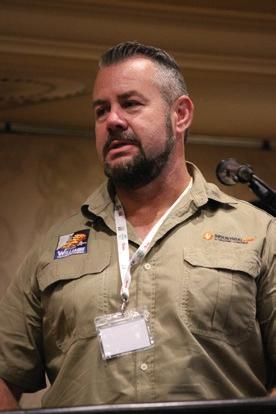
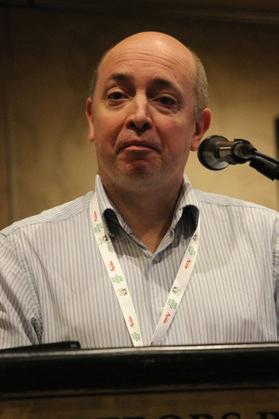

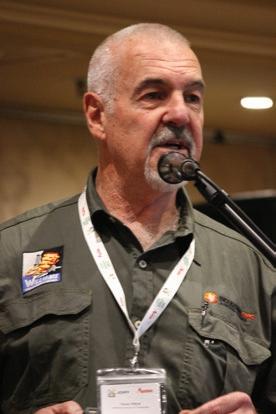

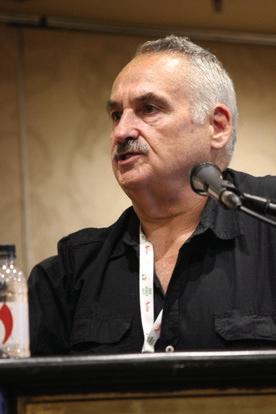
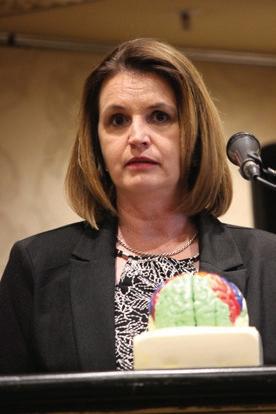
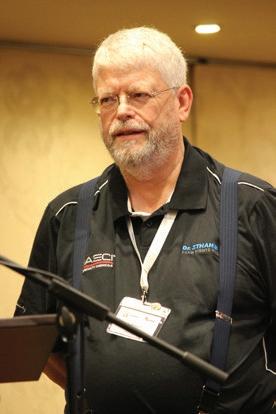
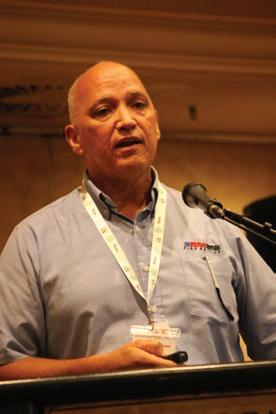
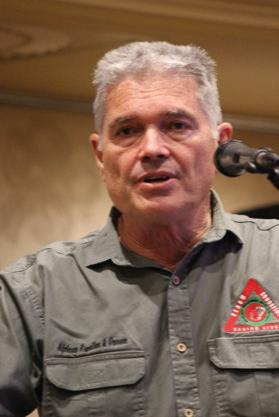
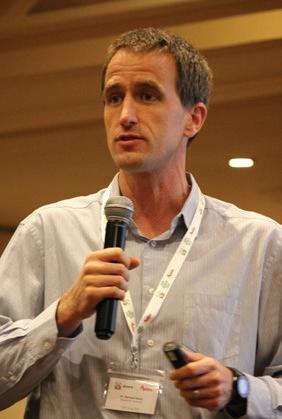



22








23
AECI Speciality Chemicals receives another clear audit from Dr Sthamer Hamburg

The AECI Speciality Chemicals manufacturing plant in Chloorkop, Gauteng, has received another clear audit from DrSthamer Hamburg. The biennale audit took place in November 2022 with representatives of DrSthamer Hamburg facilitating the audit and the facility received certification for the manufacture and distribution of a range of products.

The audit by DrSthamer Hamburg representatives included raw material’s arrival, storage, testing, weighing and the production operations in order to certify the quality control process. It includes an ISO 9000 audit.
During the recent audit, recommendations were made for more cost effective methodologies.
AECI Specialty Chemicals, a division of AECI Limited, has been manufacturing and distributing DrSthamer fire fighting foams under license for a number of years
and is expanding its association with DrSthamer Hamburg to manufacture more products locally.
Together with the long relationship and commitment to quality, AECI Specialty Chemicals has been awarded the right to manufacture and distribute DrSthamer Class A foams and the UltraWet wetting agents. The UltraWet wetting agents are used for the suppression of wildfires.
Products are manufactured and tested for quality control at the Gauteng facilities and the laboratories conduct routine customer sample testing to ensure that the products on the customer’s site still conforms to specifications.
AECI Specialty Chemicals offers the whole spectrum of fire fighting foams including the latest fluorine free foams, alcohol resistant foams and products carrying specific approvals obtained from the manufacturing facilities in Hamburg, Germany.
The company has been manufacturing Dr Sthamer Hamburg fire fighting foams for more than 30 years. AECI Speciality Chemicals is also the only plant manufacturing Dr Sthamer fire fighting foams outside of Hamburg in Germany.
Having branches in Gauteng, KwaZulu-Natal and a warehouse in the Western Cape, ensures a good footprint in the whole of South Africa. Due to AECI’s footprint in the rest of Africa, supply into sub-Saharan Africa is relatively trouble free.
DrSthamer Hamburg based in Germany started in 1886 and manufactures fire fighting foams for the municipal, petrochemical, industrial, marine, aviation, mining, wildfire and waste and recycling industries for Class A, A/B, B and Class F fires including high expansion foam, medium expansion foam, low expansion foam, wetting agent and CAFS.
Volume 6 | No 6 24 | FIRE AND RESCUE INTERNATIONAL
Back to Contents
RLF 4 for Class AFires
Super Hi-Ex for A&Bclass fires as well as foamparties
Sthamex UltraWet as wetting agents
Airmaster for aerial bombing
Barricade Fire Blocking Gel
Fluorine Free Fire Foam
Local technical laboratories
Local Manufacture

AECI Specialty Chemicals manufactures all Dr. STHAMER Hamburg products under license in South Africa


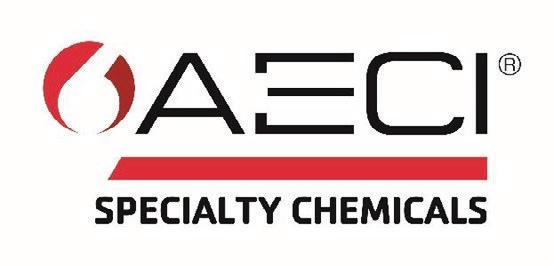
STHAMEX AFFF 1%, 3% & 6% for hydrocarbon fires
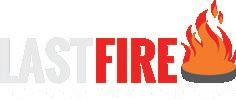

STHAMEX MOUSSOL APS for alcohol fires in 1/1 ,3/3 and 3/6 with 1A/1A approvals

New environmentally friendly Flu orine Free range
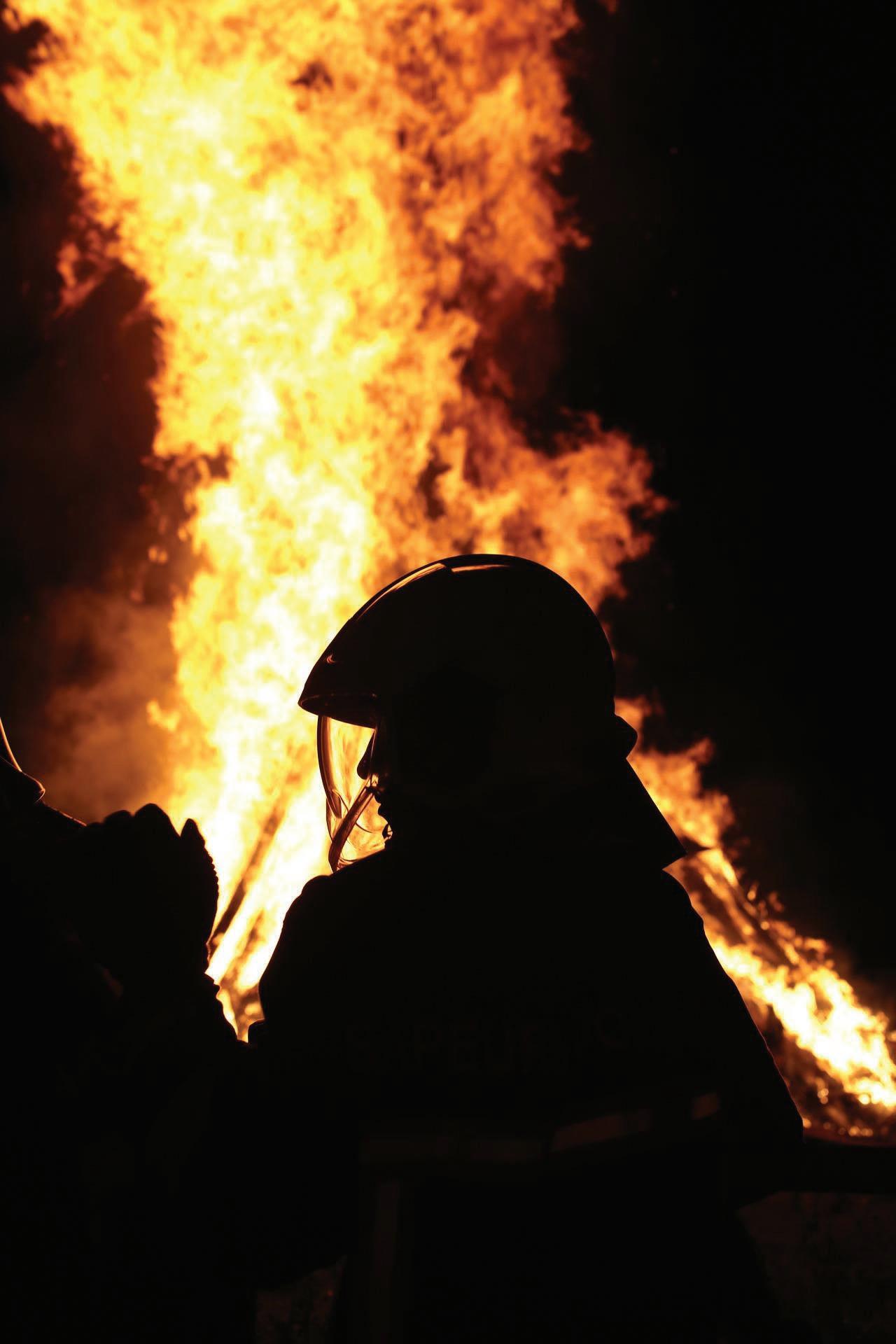
AECI Specialty C hemicals, a div ision of AECI Lt d
ica
H as an excellent history of f ighting fires in South Afr
Contact: Marinus Scott on +27 82 330 6250 marinus.scott@aeciworld.com Jason Grey: Cape Province +28 82 891 4264 jason.grey@aeciwold.com www.aeciworld.com
All products carry EN 1568 approvals ISO 9001, ISO 14001, OSHAS 18001 Responsible Care Certificate
DoseTech special risk industrial fire protection
DoseTech specialises in fire protection foam dosing technology and special risk fire fighting hardware. Their product range includes foam dosing systems, control valves, fire hydrants, foam concentrate, foam equipment, manual valves, fire fighting water cannons and fire fighting nozzles. “Our product range is of the highest quality and comprises a selection of European and USA fire fighting and protection equipment, manufactured to ISO
9001 standards and are FM, VdS, UL or NFPA approved, ensuring the best performance, long term service life and reliability,” said Mike Feldon, managing director of DoseTech.
He added, “We are totally focused on the fire protection industry, with the success of the FireDos unique foam concentrate dosing system, the complete range of Akron Brass products, which include nozzles, monitors, accessories and JamesJones hydrants from Mueller Co.
Although DoseTech represent quite a few brands, they shared the interview by FireDos, one of DoseTech’s global partners.
An interview with Mike Feldon by FireDos
The partnership between DoseTech and FireDos has existed for over 20 years. Feldon is not only a FireDos veteran but also an expert in the field of Special Risk Industrial Fire Protection. We asked him a few questions and



26 | FIRE AND RESCUE INTERNATIONAL Volume 6 | No 6 Industrial fires
Commissioning Cape Town harbour sea water FD20000/1/3 foam proportioner with Ingo Wosch and Heinrich David, the founder of FireDos (on the left), Mike Feldon, JB Potgieter and Greg Buchanan from DoseTech
Mike Feldon and JB Potgieter
Back to Contents
The DoseTech team
went on a little journey through time. “Once the industry embraced the FireDos technology and benefits, we began to successfully supply many projects, covering a wide range of industries and applications,” said Feldon.
FireDos specialises in the development and production of innovative and reliable proportioning systems and extinguishing monitors for fire fighting. 13 000km in the south:



DoseTech is one of FireDos’ southernmost partners. What is the core competence of DoseTech?

Feldon said, “DoseTech moved into the fire foam proportioner industry 23 years ago when we secured the FireDos agency, our focus is special risk industrial fire protection.”
How did you come to this business?
DoseTech was originally a chemical dosing pump company marketing electric motor dosing / metering pumps. In 1998 we

were introduced to the MSR Dosiertechnik (former FireDos company) and to the water motor dosing / proportioner industry from FireDos. I ‘fell in love’ with FireDos foam proportioners and made it my mission to introduce this amazing technology to the South African fire protection industry. This was a challenge due to the extremely conservative nature of the fire industry. They like to stay with what they know, even if the technology is old or troublesome, rather
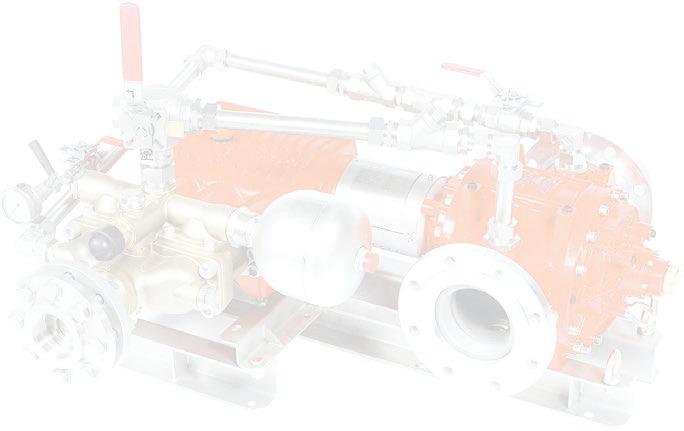
FIRE AND RESCUE INTERNATIONAL | 27 Volume 6 | No 6 Industrial fires
+27 (0) 861 111 544 • Mike – mgf@dosetech.co.za firedos@dosetech.co.za • www.dosetech.co.za FireDos foam dosing proportioners and skids • Monitors and water cannons • Mobile dosing and monitor trailers • Bund, tank top and rim
Future proof your fire protection system with Speak to the company that knows foam systems best Efficient • Effective • Easy to use & test ALL INDUSTRIAL, MOBILE, SPRINKLER REQUIREMENTS
pourers
Back to Contents
Commissioning the first M9 monitor in the world and in South Africa as well as a FireDos FD20000/3 proportioner, in Durban using food colouring as foam simulation
than going with new technically beneficial technology. Once the industry embraced FireDos technology and benefits, we began to successfully supply many projects covering a wide range of industries and applications.
What is special about the South African market?
“Our market is very diversified. Our challenges remain the ‘old technologies’, which leads into our goal of continuing to become a reliable, knowledgeable product/ industry specific expert and information resource plus bring new technology and complete solution to our local market. Currently we are busy with petrochemical refineries and fuel storage depots, a sugar mill, a warehouse, an edible oil production and an ‘Isuzu’ paint shop in the new factory.”
For how many years do you work with FireDos? What was your personal highlight?
“I have personally been involved for 23 years now. This means I saw the old MSR company manufacturing blue pump proportioner throughout the factory and watched over the
years the red FireDos pump slowly take over the FireDos manufacturing facility as the foam proportioners demand grew. There were steady technical developments and innovations of both the proportioner and the monitors, resulting in the current smart and robotics technology, which is the next area of our growth and development as we look for opportunities for this latest technology.”
“My personal highlight was the opportunity to start up a new business with my father and FireDos and to see this become a success together, plus the privilege to have worked with the David family as they grew FireDos into the globally successful product we know today, adding the personal mentorship I received from Heinrich David through all the years I worked with him, which ultimately had a massive impact on our success in the fire industry.”
“Other highlights are all the firsts that we can brag about:
• First FireDos proportioner supplied into South Africa, Namibia, Mozambique, Botswana,
Zimbabwe, Ghana, DRC, Mali, Malawi and Nigeria.
• First M9 monitor installation, delivered to Durban
• First FireDos proportioner trailers in South Africa

• 271 FireDos proportioners sold by DoseTech”
You work where others spend their holiday, what is your ‘secret place’?
“I am very much privileged to work and live in Cape Town. I grew up in Johannesburg, a big concrete jungle and moved to Cape Town in 1992 to start a branch for a steam reticulation company. Then I had the opportunity to start a business with my father and my wife. We built a business, a family, educated our daughter in Cape Town, now Stellenbosch University. I made this city my home, said Feldon.
Cape Town is a very special place. As you rightly state, everybody wants to come here for a holiday.
What do you associate with FireDos?
“Quality, reliability, technically advanced with innovative technology, friendly, very easy to do business with and supportive.”
28 | FIRE AND RESCUE INTERNATIONAL Volume 6 | No 6 Industrial fires
Back to Contents
One of Mike’s favourite projects: the installation of a FireDos foam proportioner at the Christiaan Barnard Heart Hospital helicopter landing deck. In the background a fuel ship offloading protection system where a FireDos FD20000 sea water foam proportioner had been installed
Corona, Ukraine … the world is changing; how did and does this influence the team spirit of DoseTech?

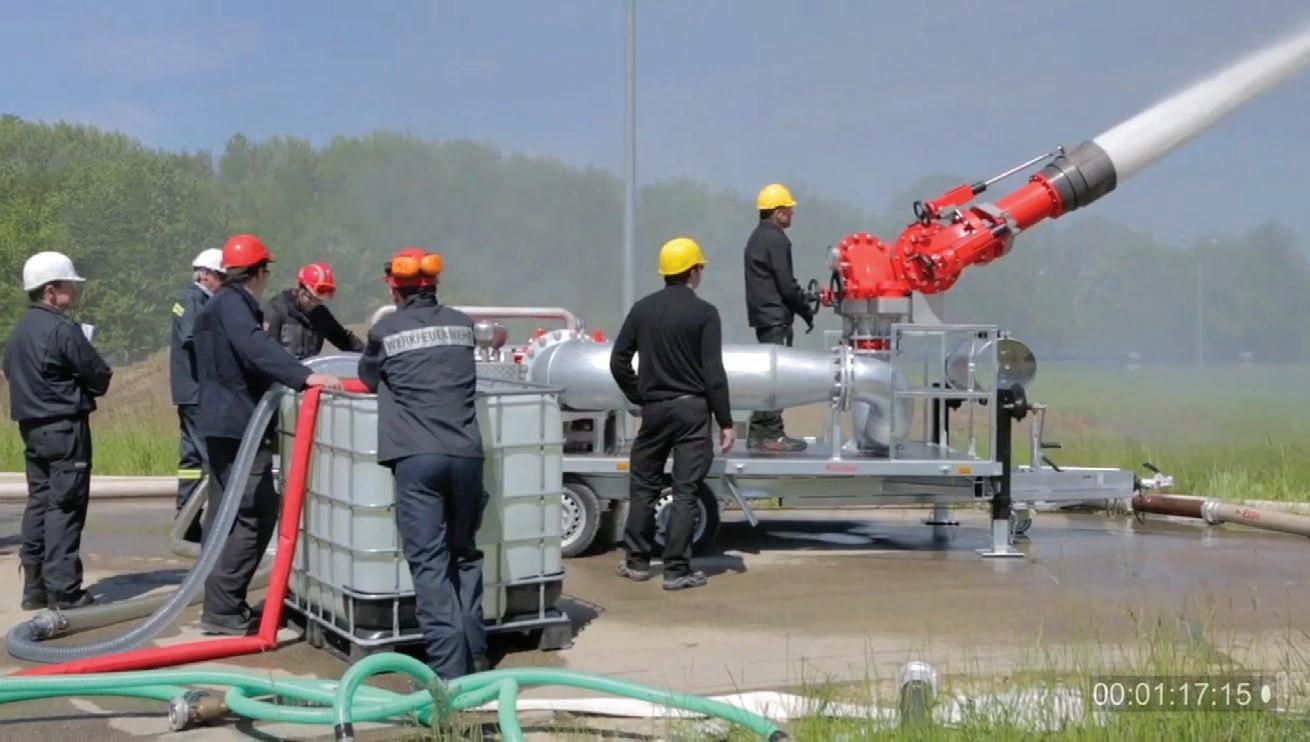
“From the start of Corona lock down when we sent our employees home, I adapted a new philosophy: resolute and optimistic, with a positive approach to getting

through the challenges. And we did. Once we were allowed to move out of our homes, my team requested that we open the office and get back to ‘normal’, which we did. This had a great benefit to general moral. The war in Ukraine is a major concern.”
What is your future wish?
“World unity and peace and to grow our business, increase the knowledge about FireDos products and systems in our market, to improve our own knowledge and skills.” , said DoseTech Fire’s Feldon.

FIRE AND RESCUE INTERNATIONAL | 29 Volume 6 | No 6
Industrial fires Back to Contents
The Christiaan Barnard Heart Hospital helicopter landing deck in front of Table Mountain
New non-fluorinated Thunderstorm WNF33A foam concentrate advances fire protection for flammable liquid storage tanks


Williams Fire and Hazard Control has announced the launch of Thunderstorm WNF33A 3%x3% non-fluorinated foam concentrate, the newest addition to the renowned Williams Fire and Hazard Control fire fighting foam portfolio and which is now available through Industrial Fire and Hazard Control in South Africa.

Fuel in-depth fires and sunken roof hazards can occur at flammable liquid storage facilities, oil and gas tank farms, refineries and petrochemical processing operations. Historically, non-fluorinated foams have been challenged to deliver the performance of a traditional alcohol-resistant aqueous film-forming foam (AR-AFFF) for Class B fire fighting on these types of hazards. The new Thunderstorm WNF33A Foam Concentrate provides excellent fire and vapor suppression for hydrocarbon fuels, such as gasolines and diesel, as well as for
polar-solvent fuels, such as alcohols and ketones.
‘We’ve rigorously tested
Thunderstorm WNF33A Foam Concentrate and it demonstrates excellent control and extinguishment for large, hydrocarbon tank fires similar to legacy Thunderstorm foam products,’ said David Ash, product director of Firefighting Foam Products, Johnson Controls. ‘It’s also highly effective when used to fight flammable liquid spills.’
Proven performance
During recent 12m tank fire tests at the Industrial Rescue Instruction Systems Training Center in Beaumont, Texas, Thunderstorm WNF33A was evaluated at an application rate of 3,2l/min/ m2, which is half the design rate recommended by UL 162 and NFPA 11 industry standards for hydrocarbon fuel in-depth
fires. Control of the tank fire was established in approximately two minutes, comparable to that of legacy Thunderstorm foam concentrates on similar 12m tank tests. Its long-lasting foam blanket also demonstrated strong burnback resistance and post-fire suppression.
Thunderstorm WNF33A Foam
Concentrate has a viscosity similar to its AR-AFFF predecessor and can be used with most conventional response proportioning and discharge devices. This foam concentrate produces a robust foam blanket at expansion ratios as low as 3:1, so it can be applied with non-aspirating nozzles and deliver significant throw distance. It can also be used in conjunction with dry chemical agents for dual fire fighting application.
Backed by the industry leader
Continuing the renowned, 70-year heritage of Thunderstorm foams from the Williams Fire and Hazard Control product portfolio as well as other Johnson Controls fire protection products and solutions, Thunderstorm WNF33A Foam Concentrate delivers the fire fighting performance needed to respond with confidence to today’s most challenging oil, gas, chemical and industrial fires.
Thunderstorm WNF33A Foam
Concentrate is a GreenScreen
Certified Silver formulation. As a non-fluorinated foam concentrate, it doesn’t have any intentionally added PFAS chemistry, is produced in equipment that has not handled PFAS chemistry and inherently complies with Directives (EU) 2017/1000 on PFOA and 2019/1021 (EU POPs directive).
30 | FIRE AND RESCUE INTERNATIONAL Volume 6 | No 6 Industrial fires
Back to Contents
THE NEW HIGH PERFORMANCE T-STORM NFF 3X3 UL210 FOAM CONCENTRATE FROM THE MARKET LEADERS IN FIREFIGHTING FOAMS.

Now there’s a new WILLIAMS FIRE & HAZARD CONTROL® concentrate that utilizes Non- Now there’s a new WILLIAMS FIRE & HAZARD CONTROL® concentrate that utilizes Non- there’s a FIRE & CONTROL® Fluorinated Foam (NFF) technology to deliver performance that redefines the Fluorinated Foam (NFF) to deliver performance that redefines the Foam (NFF) performance that the category. T STORM® NFF 3x3 UL201 foam concentrate has been verified by an category. T STORM® NFF 3x3 UL201 foam concentrate has verified by an UL201 foam has independent, 3rd party to achieve control and extinguishment on hydrocarbon fuel independent, 3rd party to achieve control and extinguishment on hydrocarbon fuel independent, and fires at the same application rate as a UL 162 listed 3x3

Alcohol-Resistant AFFF (AR- fires application as listed AFFF (ARAFFF). To discuss complete multi stage solutions in transitioning to Non-Fluorinated AFFF). To discuss multi stage solutions in transitioning to Non-Fluorinated multi stage transitioning to
Alcohol-Resistant AFFF (AR- fires at the same application rate as a UL 162 listed 3x3
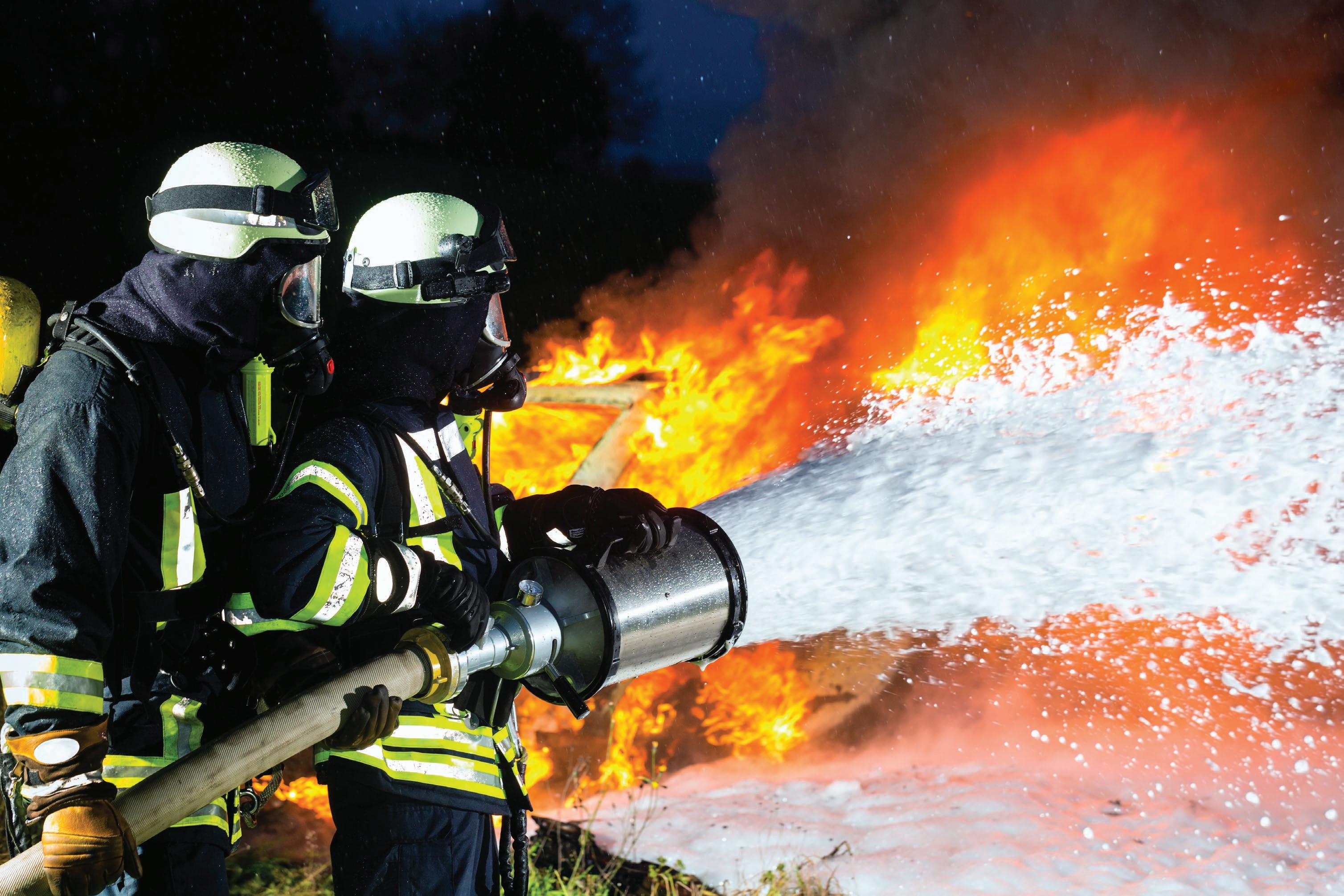
Foam technology,
(01)11 869 2142 and ask for Trevor, Zarto or Lee. Foam technology,
+27 (01)11 869 2142 and ask for Trevor, Zarto or Lee. technology, +27 2142 for Trevor, Zarto Lee. w w w . i n d u s t r i a l f i r e . c o . z a zarto@industrialfire.co.za / +27 (0)61 158 6941 lee@industrialfire.co.za / +27 (0)61 225 2710 trevor@industrialfire.co.za / +27 (0)82 651 2580
please call +27
please call
Protecting you every step of the way: the history of Dräger SCBA
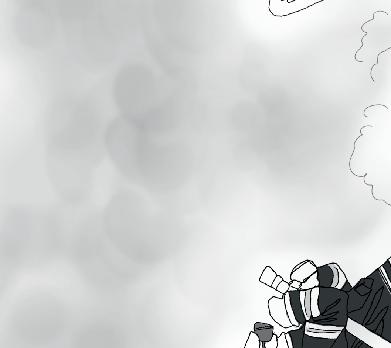
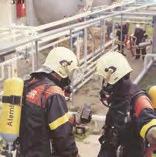

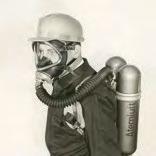

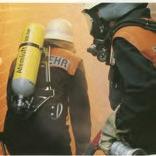
“During the first decade of the 20th Century,






Protecting You Every Step of the Way
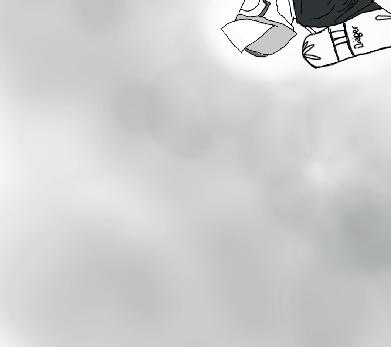
England and Mexico and even mountaineering rescue squads in England became accustomed to the reliability and performance of using their Dräger breathing apparatus. Word spread quickly about the great success of the breathing devices due to their use in the harsh environments of underground mines, at high altitudes and from news of the esteemed awards given Dräger for the apparatus at the St Louis World’s Fair. ‘Many heroic deeds were being performed in our apparatus’, wrote Heinrich Dräger in 1913.”
The history of Dräger SCBA
~ Merritt Long, Firefighting History and Traditions

For us an SCBA set is part of the fire fighter, which supports him during an incident.
“During the first decade of the twentieth century, mine rescue teams across Germany, England and Mexico and even mountaineering rescue squads in England became accustomed to the reliability and performance of using their Dräger breathing apparatus. Word spread quickly about the great success of the breathing devices due to their use in the harsh environments of underground mines, at high altitudes and from news of the esteemed awards given Dräger for the apparatus at the St. Louis World’s Fair. ‘Many heroic deeds were being performed in our apparatus’, wrote Heinrich Dräger in 1913.”
Our passion is Technology for Life, which supports the fire fighter during that incident. To simply fulfil standards is not enough; we take those requirements a step further; we continuously strive for better design, improved application, easier maintenance and uncomplicated logistics.
Throughout the past 80 years, our goals have not changed: to reduce breathing resistance, weight and dimensions using modern
Our passion is Technology for Life, which supports the firefighter during that incident. To simply fulfil standards is not enough; we take those requirements a step further; we continuously strive for better design, improved application, easier maintenance, and uncomplicated logistics.
materials. Down to the smallest technical details, we’ve introduced features such as: balancing medium pressure, safety whistle close to the wearer and materials with closed surfaces on the carrying system; all to help improve the daily business of an SCBA set. This even includes solutions such as upgrading the mask’s visor so the wearer has a more natural field of vision.
Throughout the past 80 years, our goals have not changed: to reduce breathing resistance, weight, and dimensions using modern materials. Down to the smallest technical details, we’ve introduced features such as: balancing medium pressure, safety whistle close to the wearer, and materials with closed surfaces on the carrying system - all to help improve the daily business of an SCBA set. This even
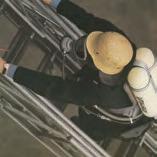
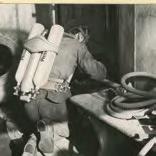
Our aim is for every wearer to be able to concentrate on the incident at hand, trusting that Dräger will deliver robust and reliable self-contained breathing apparatus, which have thus far, stood the test of time.




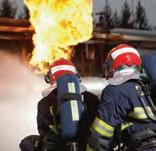
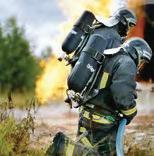


includes solutions such as upgrading the mask’s visor so the wearer has a more natural field of vision. Our aim is for every wearer to be able to concentrate on the incident at hand, trusting that Dräger will deliver robust and reliable self-contained breathing apparatus, which have thus far, stood the test of time.
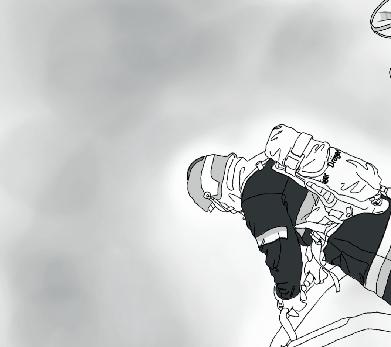

Our never-ending pursuit for new technologies keeps us asking the same question consistently, why do we do what we do? The answer has always remained the same: to save lives. Throughout its developmental history, we have strived to use new innovation and ideas to continuously improve the Dräger SCBA because we want to protect you every step of the way.
Our never-ending pursuit for new technologies keeps us asking the same question consistently, why do we do what we do? The answer has always remained the same: to save lives. Throughout its developmental history, we have strived to use new innovation and ideas to continuously improve the Dräger SCBA because we want to protect you every step of the way.
We work tirelessly to offer you SCBAs with improved performance and functionality. “We share the same passion – saving lives and are proud to support you to go in prepared.” ~ Stefan Dräger.
32 | FIRE AND RESCUE INTERNATIONAL Volume 6 | No 6 Strap
PPE and cancer prevention
mine rescue teams across Germany,
WE WORK TIRELESSLY TO OFFER YOU SCBAS WITH IMPROVED PERFORMANCE AND FUNCTIONALITY.
FOR US AN SCBA SET IS PART OF THE FIREFIGHTER, WHICH SUPPORTS HIM DURING AN INCIDENT.
“We share the same passion – saving lives –and are proud to support you to go in prepared.”
Stefan Dräger
1951 PA30 1941 1953 1969 1992 1997 MODELL 10 PA34 PA54 PA90 & PA94 PSS® 500 2000 2010 2015 1953 PSS® 90 PSS® 3000 PSS® 4000 DA58 2010 2021 PSS® 5000 PSS® AIRBOSS 1975 PA80 1995 PA90 PLUS & PA94 PLUS 1998 PSS® 100 2007 PSS® 7000 Back to Contents
Merritt Long, Firefighting History and Traditions
Fighting cancer in the line of duty

Practical ways to reduce health risk caused by contamination in the Fire Service


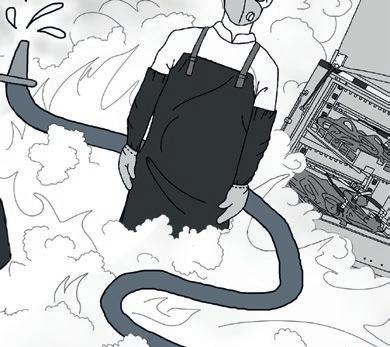
WHICH SOPS ARE COMPULSORY AND SHOULD BE LEARNT BY EVERY FIREFIGHTER?
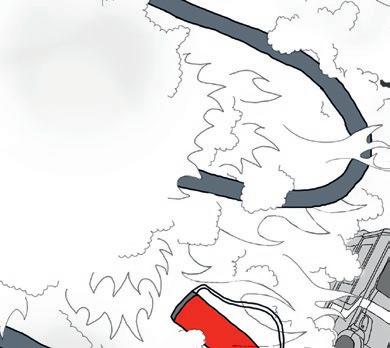
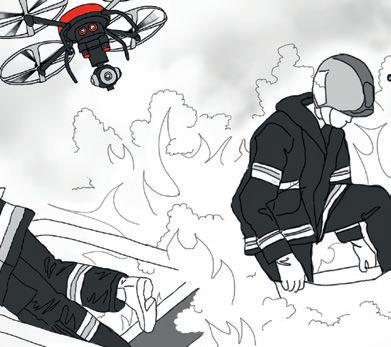
• Identifying and understanding hazards
• Selecting and using protective equipment
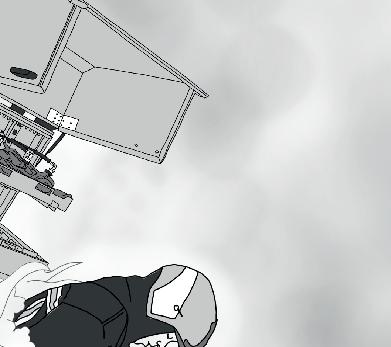
• Using PPE wisely and according to the donning doffing routines
• Applying personal hygiene routines after incidents
Training 1 1


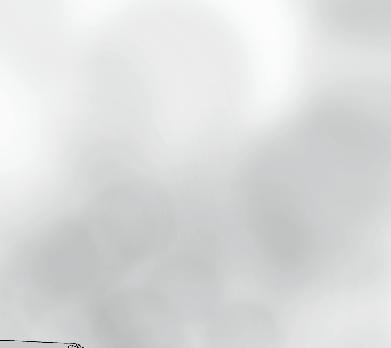
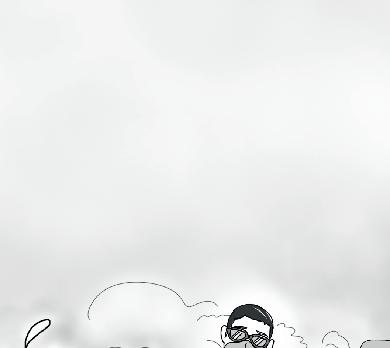


Readiness 3 Incident 2
HOW CAN YOU MINIMIZE THE RISK OF DIRECT CONTAMINATION?

• Avoid exposure to hazardous substances wherever possible for teams as well as equipment
























• Wear PPE and breathing protection at incident site
• Avoid direct contact with contaminated equipment during pre-decontamination ‒use PPE
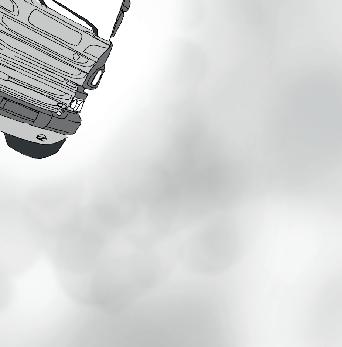
• Clean skin during doffing of PPEs to remove contaminants

• Pack and stow contaminated PPE and equipment in sealed bags / containers; document the type of incident for further handling
HOW CAN YOU MINIMIZE THE RISK OF INDIRECT CONTAMINATION?




• Clean PPE routinely after use at any incident
Protecting you every step of the way 2 3


• Treat returned PPE as contaminated equipment and protect service technicians accordingly
























• Consult your PPE supplier for guidance on cleaning processes







Battling an unseen danger: cancer amongst fire fighters
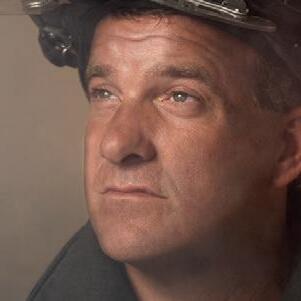


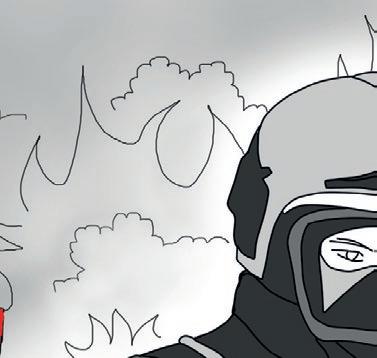
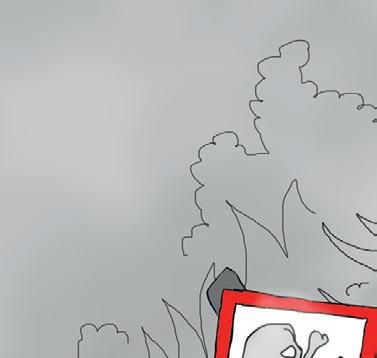
TProtecting you every step of the way
















The risk of contracting cancer is much higher than in other jobs, as recent studies impressively show. So the question arises: what needs to change and how?
Higher risk of contracting cancer























































Those who put others at the center of their work, must not forget themselves.
hose who put others at the centre of their work, must not forget themselves. Especially in an emergency when the pressure is up and every second counts the sole focus of fire fighters is on saving other´s lives. But all too often it is overlooked that they themselves could become victims: by getting exposed to carcinogens.


Why is cancer a greater risk amongst fire fighters?



The call comes in. The team dons their turnout gear. The truck is ready to go as the sirens are turned on. They answer every call, no matter the danger, to save those in need. To us they are: strong, courageous and selfless. But they are neither invulnerable nor immune as we think they are. They are ordinary men and women, brothers and sisters, fathers and mothers with families who share their sense of honour and passion for what they do.
»I thought of everyone else first and I thought of myself last.«








And like all of us, they can be victims of unforeseen health dangers. But unlike us they face a higher health risk from their profession. According to the US Centre for Disease Control and Prevention (CDC), a fire fighter has a 29 percent higher risk of contracting various types of cancer than the rest of the US population. They have a 1,39 chance higher of developing skin cancer and are 1,31 times more likely to be diagnosed with brain cancer in America alone. Our modern life consists of buildings, interior, furniture etc, which contain synthetic/engineered materials. If these objects burn they expose ‘cocktail’ of cancer-causing and toxic substances.
Especially in an emergency when the pressure is up and every second counts the sole focus of firefighters is on saving other´s lifes. But all to often it is overlooked that they themseves could become victims: by getting exposed to carginogens. The risk of contracting cancer is much higher than in other jobs, as recent studies impressively show. So the question arises: what needs to change and how?
34 | FIRE AND RESCUE INTERNATIONAL Volume 6 | No 6 © Drägerwerk AG & Co. KGaA Whitepaper Cancer Awareness ‒ Incident © Drägerwerk AG & Co. KGaA
ST-1178-2008 2
PPE and cancer prevention
Back to Contents
In the heat of the battle you can easily forget about your personal protection procedures
Ways to improve the situation
The question arises: what needs to change and how? Identifying their key needs and raising awareness about this critical issue will play a key role in promoting the health of our fire fighters today because their well-being and health has been in the background too long.
Fire Services across various continents have begun to realise the scope and magnitude of carcinogenic exposure to fire fighters.
A white paper printed by the Fire fighter Cancer Support Network (FCSN) outlines extensive studies conducted which provide much needed knowledge and insight as to today’s new challenges faced by fire fighters.
Is a ‘real’ fire fighter, a ‘dirty’ fire fighter?
Perhaps one oversight lies with our personal perception of what a fire fighters should ›look like‹. The popular image of fire fighters facing blazing

flames and returning sooty and often with doffed breathing protection equipment, has become an iconic visual representation of a ‘strong’ person battling the forces of raging fires and clouds of dark suffocating smoke.
However, if we look closely at this image, we can see that they are completely exposed to toxic byproducts, which are released with fury in the event of a fi re. This leads us to question the myth: Is a real fire fighter, a dirty fire fighter?
Misconception must be dispelled
We hold them in such high esteem, and rightly so. Today however, we need to dispel this misconception: that in order to do their job to the fullest, they need to emerge from the fire, coated with soot and personal protective equipment removed.
There are numerous ways they are exposed to carcinogens: for example, inhaling toxic fumes directly into their lungs due to the

removal of SCBAs. Furthermore, the soot and residue from fires can also be absorbed through their skin. Carcinogenloaded turnout gear and helmets aggravate the exposure.
Analysing the potential risks

An analytical approach at the incident level of fire suppression and postincident processes are vital to identify the risks of toxic, carcinogenic substances. Best practice models, such as the well-known Skellfteå Model, published by the Swedish Civil Contingencies Agency, serves as an example as to how Fire Services across the world are pooling their expertise in promoting and providing sustainable solutions to fight cancer amongst their fire fighters. Analysing fire suppression incidents as well as best practice models break down stereotypes and expose the dangers and risks associated with the health and safety of fire fighting.
Improving routines and workflows
The gist is to improve routines and workflows in the working environment: mitigate exposures, expedite implementation, and adjust standard operating procedures (SOPs). Consequently, encouraging awareness and to actualise changes which would lead to commitment.
FIRE AND RESCUE INTERNATIONAL | 35 Volume 6 | No 6 PPE and cancer prevention
“Pinpointing the cause of cancer is extremely difficult because fire fighters are not exposed to just one agent. They are exposed to multiple cancer causing agents. Because of the multiple exposures and the multiple routes of exposure; they inhale carcinogens and carcinogens are absorbed through the skin, it is also highly unlikely for fire fighters to get only one type of cancer”
~
Grace LeMasters, PhD,
a professor of epidemiology at the University of Cincinnati
Dräger website
Back to Contents
How do fire fighters get exposed to hazardous substances?
Response times – making the first ten minutes count
By Colin Deiner, chief director, disaster management and fire brigade services, Western Cape Government
has been placed, up until when emergency units are notified that they have been assigned an emergency incident.
• Turnout phase: From when personnel receive the alert until they are out of the station building.
• Travel phase: Time taken to respond from their location to the incident scene.
Despite all the advances in modern fire service technology and all the innovation in fire department management aimed at improving service delivery, the speed that fire departments respond to emergencies, is the single most important factor in determining the success or failure of the responding service.
There are various tools available currently to easily measure response times and these are usually central in the measuring of employee performance in fire department management positions. The public, who rely on a service in a particular location, furthermore expect a rapid response to their call if they are experiencing an emergency, to such an extent that it has become an accepted norm for the media to report on how much time it took for the fire services to arrive on-scene. Almost every fire or
accident media report will include something about how quickly (or slowly) the fire service responded.
Unfortunately, all response times can’t be measured equally. There are a number of factors that determine how effective a response time can be and they must be seen in context to properly understand the challenge of measuring response times properly and then considering strategies to address any shortcomings that may have been identified by these factors.

If we, for the purposes of this article, agree that the term ‘response time’ is the time that is measured from the moment the call taker receives the call until the appropriate units arrive on the scene of the incident we can then break that down into three distinct, measurable phases:
• Call processing phase: The time between when the emergency call
My intention in this article is not to try and school you, the reader, in all the aspects related to these phases (you obviously know them already) but rather to look at the current reality and ask what we can do to address this. After all, the reason for our existence is to save people’s lives, save their property and make their world a litter safer and more tolerable.
Call processing phase
There are a number of systems in use that are aimed at easily identifying the location of the call taker and obtaining the pertinent information to enable a quick response. In many cases, however, such systems may not exist and it will be dependent on the experience and training of the call taker to ensure that an accurate location is established.
A clear understanding of all the services that are to be dispatched from the particular call centre is imperative. People will be calling the emergency services for a range of reasons and will be expecting an appropriate response to their dilemma.
In the not too distant past, fire department call centres were staffed by operational fire fighters
36 | FIRE AND RESCUE INTERNATIONAL Volume 6 | No 6
Response times
Back to Contents
The speed that fire departments respond to emergencies, is the single most important factor in determining the success or failure of the responding service
as part of their shifts. Although this was not a popular chore, it did have the advantage that the person taking the call usually had a thorough knowledge of the city/town and, more often than not, had some knowledge of the predicament that the caller was in. This enabled the call taker to dispatch the correct resources and ensure that the caller was well aware of what to expect.
With the advent of “specialist” call takers, this has changed. We often find that many of these people are junior personnel who have limited

knowledge of the needs of affected people. To address this, staff must be trained to know what questions to ask in each specific situation and also have access to an experienced supervisor who can guide the response in the right direction.
Around 2011, I was approached by the legendary Dr Alan McMahon from the Western Cape Emergency Medical Services to establish a coordination centre in our Provincial Disaster Management Centre. The objective of this facility was to ensure that all emergency calls coming in was met with the best
possible response and that the entire incident was managed from the emergency units leaving their bases right through to the delivery of the patient(s) to the definitive health care facility. The centre would be staffed by experienced EMS officials with years of experience working “on the road”.
Soon after the centre was established, a horrific passenger bus accident took place In the Hex River Valley approximately 120 kilometres from Cape Town. Several children were on board the bus and many were tragically killed or seriously injured. In the initial response a variety of ambulances from Government and private ambulance services transported these patients to different facilities in the Breede Valley area causing significant confusion as to the whereabouts of the patients. The bus had wedged itself up against a solid rock wall, which trapped a number of the passengers on that side of the vehicle requiring heavy hydraulic and pneumatic rescue equipment to release them.
It is at this point where the coordination centre really showed its value.

FIRE AND RESCUE INTERNATIONAL | 37 Volume 6 | No 6 Response times
In your operational planning and crafting your SOPs, one of the first considerations should be your Pre-Determined Attendance (PDA)
Back to Contents
A organised and managed coordination centre really show its value during major incidents
Arrangements were made to move all patients to the Red Cross Children’s Hospital in Cape Town and the Metro Heavy Rescue Unit was dispatched to the scene to assist in the extrication operation and the stabilisation of the vehicle. In a short period of time, the centre staff were able to locate all the patients and arrange for them to be moved to the helipad at Worcester Hospital where an Air Force Oryx helicopter, together with provincial helicopters, were able to airlift them to Cape Town.
A further advantage was that rescue personnel could provide photographs and video footage to the centre where the head of provincial EMS and other rescue specialists could provide advice on a very complex extrication operation.
The above example demonstrates the need to ensure that accurate information is garnered from the caller at the time of the first call.
With the saturation of cellular phones in our society, it is certain
that an incident taking place in a public area will result in several calls being made to the emergency services reporting the same incident.

The question here is: Does your call centre have a system to deal with multiple calls coming in from the same incident? It will be important to question more than one caller as this could allow your team to get as much information as possible. A final thought on call taking: Information is shared on many platforms and across a range of applications. Does your centre have the capability to enable the public to report incident s across these platforms?
Turnout phase
This should be a simple concept to understand. After the call taker has received the call and the appropriate resources are dispatched. How hard can that be?
I suppose the answer lies in the term “appropriate resources”. In several of my previous articles in
this publication, I have exhorted the value of a Two-plus-One response to structural fires; simply put: two engines and one ladder truck. This can only be achieved if it is department standard operating procedures (SOP) and understood by all levels of personnel from the chief operations officer, all the way down to the call-taker and dispatcher.
In your operational planning and crafting your SOPs, one of the first considerations should be your PreDetermined Attendance (PDA). What are all the resources you will need for a major hazardous materials spillage on the freeway or a trench collapse on a construction site?
It is also important when developing your PDAs to place your specialised resources at the stations that are closest to the risk. I was recently told a story of a service that responded to a high number of swift water rescue incidents in an informal settlement. Their Swift Water Rescue Unit was, however, stationed at the
38 | FIRE AND RESCUE INTERNATIONAL Volume 6 | No 6 Response times
Back to Contents
The travel phase should not only be seen as a means to transport your resources to the incident but also as a period of preparation
department headquarters several kilometres away. The reason: “That is where our special operations unit is”. It is of very little value to have a specialised resource if that resource is not able to respond as soon as possible to the emergency needing that expertise.
Expect for Rapid Intervention Teams (RITs) on the scene of a fire, there is no such thing as a reconnaissance vehicle. I have often heard about services employing a practice of sending an official to an incident to “evaluate” the situation before activating further resources. Other services employ the practice of “rapid intervention vehicles”.

The amount of resources required for a large structural fire or major hazmat operation, will quickly overwhelm the capabilities of a rapid intervention vehicle and precious time will be lost waiting for the heavy artillery to arrive. Rather send your resources back to the station if they are not required than delaying them if you are not sure that they will be needed.
Finally, I am aware of a disturbing practice within many emergency services in this country to have their senior operational officers work office hours and then respond from their homes to incidents after office hours. In many cases these officers are not provided with official vehicles but are allowed to utilise the council’s vehicle subsidy scheme. We have all been taught from our first years in the emergency services that the first ten minutes after arrival are the most critical. I don’t believe that has changed in the meantime. Do the services employing this practice realise that they are leaving the most critical time of the incident in the hands of junior responders?
Fire stations and rescue bases are mostly designed to be placed in relatively close proximity to the highest risks. Why then have your incident commander be the last person to arrive? Are your first-in units able to do as comprehensive initial assessment as your incident
commander? If so, how do you substantiate the time taken for this unit to do a handover when the IC does eventually arrive?
Travel phase
The travel phase should not only be seen as a means to transport your resources to the incident but also as a period of preparation.
There are a number of activities that can be done inside the crew cab such as donning breathing apparatus, preparing PASS devices and radios and observing weather conditions and any other possible challenges as you approach the scene. It is also a period where crews can mentally prepare themselves for the incident they are responding to. If the caller indicated many trauma victims it will be a mentally challenging incident. Prepare for it.
Arrival at a scene will have a few requirements. Firstly, are you the first arriving unit? If you are, your vehicle’s safe and effective positioning will be your first consideration.
When approaching a hazmat scene, it would be required that responding units first stop and observe the incident from a safe distance. A toxic gas cloud or compressed gas container involved in a fire will require you to establish a significant safety zone around the incident. A vehicle accident requiring extrication will need you to park as close as possible
to the vehicle wrecks so that you can deploy your heavy hydraulics without delay. You will still have to do this taking into account all the possible hazards that may prevail such as fuel spills, downed power lines, road conditions, etc.
If you are not the first arriving unit, you may be diverted to a secondary staging area. Make contact with the first-in incident commander enroute to confirm your initial position upon arrival.
In closing
There is a massive amount of training materials available on fire fighting and rescue practices, however, it seems the simple component of responding to incidents is somewhat neglected.
If we appreciate that most of our responder fatalities actually happen in this phase and that this phase is that one which will determine the ultimate success or failure of the responders, it is crucial that serious attention must be given to how your service goes about it.
Operational thinking is the most important principle in any emergency service. I often believe that we somehow get so caught up in the larger municipal, provincial or private company policies and then bend our emergency services to those policies that we lose focus on our actual mission. After all, isn’t’ that why we are there?

FIRE AND RESCUE INTERNATIONAL | 39 Volume 6 | No 6
times
Response
Back to Contents
Operational thinking is the most important principle in any emergency service
Managing and leading change in the South African fire service of the future
 By Etienne du Toit: AIFireE, PrDM, B Tech: Fire Technology (Pretoria Technicon)
By Etienne du Toit: AIFireE, PrDM, B Tech: Fire Technology (Pretoria Technicon)
Another incredibly significant development for the fire service happened on 16 February 1968 and saw the first official “911” call placed in the United States. As telephones became common in US households, fire departments around the country recommended establishing a single, simple number to be dialled in the event of a fire or other emergency.
More than 98 percent of the US and Canada can now contact emergency services by dealing 911.
Managing and leading change in the South African fire service of the future is not only necessary but also the responsibility of professional fire service leaders.
The fire service must transform to become a dynamic, forward-looking organisation, at the centre of the communities we serve, adapting to their evolving needs.
I recently read an interesting article in Fire and Rescue International aptly titled “Celebrating 50 years of Jaws of Life in Bloemfontein. ‘The first Jaws of Life was created by George Hurst in 1961 and has since become an indispensable tool for most fire services throughout the world.
I clearly remember the unmistakable sound and chocking fumes from the two-stroke Hurst power plant once started. Who can forget the weight of the spreader, especially after adding the scissor resembling shears to the device?
Fortunately, technology resulted in the
development of lightweight aircraft aluminium and other alloys which reduced the weight of the equipment. Single hydraulic hose systems coupled to four stroke and electric power sources further enhanced performance. Rescue tools operating at pressures of up to 720 bar have become the norm. New car technology has also necessitated the development of more advanced cutting equipment.
On 20 July 1969, American astronauts Neil Armstrong and Edwin “Buzz” Aldrin became the first humans ever to land on the moon. So, when NASA astronauts rapidly approached the moon 50 years ago, they relied on a computer with less than 80 kilobytes of memory.
“Today, 53 years later, a simple USB stick or Wi-Fi router is more powerful, let alone most modern smartphones. Simply put in context, most smartphone clocks are 32,000 times faster than the Apollo era computers and could perform instructions 120,000,000 times faster. In fact, one Google search uses the computing power equivalent to the entire Apollo space mission.
Today about 20 to 22 million people in South Africa use a smartphone, which accounts for about one third of the country’s population. The number of smartphone users is forecast to grow by more than five million though till 2023. https://www. statista.com/statistics/488376/ forecast-of-smartphone-users-insouth-africa/
The uncomfortable truth is, that South African Emergency Services, despite all the above technological advances at large, still fail in providing the basics, for example a single emergency number.
Admittedly, there have been some movement in adopting 112 and 107, most fire services however still market their own unique 10-digit emergency number.
The fire service, by virtue of its traditional nature, has by large failed to embrace technology to the fullest, nor has it adapted to the very dynamic environment of South African local government.
The bulk of my early career was plied in combination fire/ EMS services, and I still believe that to have been the optimal model at the time. I therefore found the article in the
40 | FIRE AND RESCUE INTERNATIONAL Volume 6 | No 6
Leadership
Back to Contents
same FRI newsletter describing how the City of Tshwane has gradually phased out its ambulance service of particular interest. With effect from 16 May 2022, the rendering of emergency medical and ambulance services in the City of Tshwane will be performed by the Gauteng Emergency Medical Services and other private services. The City of Tshwane was the last remaining municipality in South Africa to render emergency medical services.
Notwithstanding, over the past 28 years, since the 1995 transformation of local government in South Africa, the fire service has been challenged to broaden its scope of services by providing in addition to firefighting also hazmat response, technical rescue, public education, fire safety inspections and a plethora of other services. The proliferation of the Wildland Urban Interface (WUI) risk has resulted in fires and devastation on a scale never seen before. Socio-economic challenges created by rapidly evolving informal urbanisation pose major fire and life safety risks to a significant proportion of the population. These expanded services place a huge burden on current fire service delivery model.
The future role of the fire service is clearly defined in the White Paper. This paper proposes a move from the traditional reactive model of fire service delivery to one that is more predictive. This will require the use of data to enable evidence-led decisions to improve the services we deliver. There is certainly no shortage of incidents or needs for the fire service in our communities. Both prevention and risk reduction are cornerstones of the proposed legislation that is bound to follow the White Paper. The former will, once fully effected, inevitably reduce both the frequency as well as severity of incidents. Critical thinking will therefore be required to answer the following:
• Is the current service delivery model that we use to provide service to our communities still relevant?
• How to adjust the current service delivery model to meet the future needs of the community?
• What is the cost of a new service delivery model?


• How can the fire service remain relevant within the evolving needs such as provincialisations of the emergency medical service and the future reduction in calls?
• How can the fire service introduce technology into its service delivery models?
Fire service leaders, need to build relationships with their communities. The service must harness and provide data to motivate the need for increased resourcing of our plans. Failure to engage elected political structures may result in uninformed decisions about the future of the fire service and associated unintended consequences.
The challenge for traditional fire service leadership is to step up and examine what the fire service could become if we move beyond the boundaries or limitations that we have imposed on ourselves. The all too familiar, “that won’t work here” or “we

don’t have the money” is completely understandable but growth will not be possible if we are not planning and developing for the future. I can only imagine the scepticism with which the first Jaws of Life was received back in 1961, yet today it is possibly one of the most widely used tools in any rescue arsenal. The same could be said about the 911 single emergency number, which has directly and indirectly contributed to saving countless lives. Comprehensive but also realistic plans will grow the service, we cannot grow if we are not developing and planning. The solution is to evolve holding onto our values but expanding how best we serve our communities.
As leaders in our respective organisations, it is not only our duty but we are both legally as well as morally obliged to ensure that those who rely on our guidance and direction receive the leadership they deserve.
FIRE AND RESCUE INTERNATIONAL | 41 Volume 6 | No 6 Leadership
Back to Contents
Rescue South Africa: Disaster response team on the brink of disaster
In 1999, a group of volunteer paramedic fire fighters decided to go abroad and assist after an
earthquake in Izmit, Turkey. This rescue mission revealed to the team a very serious skills shortage
in search and rescue in Southern Africa. Out of this was born the concept of Rescue South Africa. As a result, in 2001 the NGO/NPO organisation was formed.
“The vision was to enable Africans to be good citizens of the world, to show the world that Africans can help themselves and offer humanitarian services worldwide. To make a difference”, said Rescue South Africa’s Ian Scher.
Rescue South Africa had three primary objectives:

• To respond to sudden onset disasters and provide technical rescue skills.
• To build a cache of equipment to be used for both training and response.
• To build capacity by offering high quality rescue training, regionally, nationally and internationally.
Rescue SA had eight American rescue technicians come to South Africa, who in turn trained 26 trainers from emergency services. This group of trainers has gone on to train thousands of South Africans right up to the level of urban search and rescue technicians.

Over the years, Rescue South Africa has built up what is now the largest cache of rescue equipment in Sub-Saharan Africa, weighing approximately 60 tons.
They have responded to various sudden onset disasters around the world, including Mozambique, Haiti, Malawi, DRC, Japan, Philippines, Iran, Pakistan and India, as well as many more within the borders of South Africa. Their responses are offered free of charge and not a single cent is earned by the members of our team, which is made up of volunteers.

42 | FIRE AND RESCUE INTERNATIONAL Volume 6 | No 6 Search and rescue (SAR)
Back to Contents
Where they are today
Their funding comes from the rescue training modules they offer to emergency service personnel as well as industrial fire departments and mines. These funds are used for the maintenance, repairs and insurance of their equipment. Whatever they have left over is put into their response kitty.
Currently, due to the COVID-19 pandemic, their training has almost completely ceased. This now puts them in a position where they are dangerously close to having to close their doors.
Hope for the future
“As a humanitarian organisation, our sole purpose, function and desire is to help those in need.
To help those who are not in a position to help themselves during their most desperate times. We run this organisation with such a huge passion, not with the desire to make money. But if we are unable to receive funding, then we are unable to respond when people need us. This fact is heartbreaking to all who have dedicated over 20
years to build this organisation. If we are unable to provide our humanitarian rescue services, it will indeed be the most regrettable end to what we truly believe has been an organisation that has saved hundreds upon hundreds of lives over the years” said Scher.


What we need
“We are appealing to the corporate
world to consider sponsoring or donating to Rescue South Africa. With any amount, large or small, you can literally save lives”, added Scher.
Banking details
Bank: Standard Bank; Branch Code: 00 43 05
Account Number: 00 247 8714 Visit

FIRE AND RESCUE INTERNATIONAL | 43 Volume 6 | No 6 Search and rescue (SAR)
Back to Contents
www.rescue-sa.co.za.
The current state of South African emergency medical services’ training
 By Oliver Wright, chief executive officer, South African Private Ambulance and Emergency Services Association (SAPAESA)
By Oliver Wright, chief executive officer, South African Private Ambulance and Emergency Services Association (SAPAESA)

On 4 November 2014, the then Minister of Health, Dr Aaron Motsoaledi, published Government Notice Number R870, which notified the public of his
intention to close the registers at the Health Professions Council of South Africa (HPCSA) to future graduates of the Basic Ambulance Assistant, Ambulance Emergency
Assistant and Critical Care Assistant qualifications.
The closure of these registers was to make way for graduates of the
44 | FIRE AND RESCUE INTERNATIONAL Volume 6 | No 6 Emergency medical services
Back to Contents
Feedback from the SAPAESA annual general meeting
The South African Private Ambulance and Emergency Services Association (SAPAESA) annual general meeting (AGM) was held in November 2022.
The event was held virtually via an online meeting platform and provided SAPAESA with the opportunity to provide members with an update on recent developments since a return to normality after the COVID-19 pandemic.
The AGM also allowed members to vote for Board and Executive Committee members for the 2023 year.
SAPAESA is proud to announce the election of the following Board and Executive Committee members for 2023:
Chairman: Clint Ruggunan Vice-Chairman: Neil Gargan
Corporate Secretary: Dave Gardner Treasurer: Terence Emslie Executive Member: Glen Preston Executive Member: Graydon Norton
The 2023 year has brought with it many challenges and it promises to be a very busy year for SAPAESA as a result.
Top of the list of SAPAESA’s priorities are a number of projects which ultimately aim to ensure a more stable economic environment for our members, as well as address the critical shortage of emergency medical services staff members that are sadly lacking within the industry.
SAPAESA is excited to be addressing these challenges on behalf of our member ambulance services and we look forward to a productive and rewarding year ahead!
National qualifications framework (NQF)-aligned Emergency Care Assistant, Diploma Paramedic and Emergency Care Practitioner qualifications to be the foundation for Emergency Medical Services (EMS) qualifications going forward.
While it is generally acknowledged that the alignment of Emergency Medical Services qualifications to the National Qualifications Framework was an important step forward in the future of EMS training, the manner in which the matter was handled by the relevant organisations left a lot to be desired.
Little effort was made by the Department of Health or the HPCSA to allow for pathways for practitioners registered as Basic Ambulance Assistants, Ambulance Emergency Assistants and Critical Care Assistants to migrate onto the updated qualifications framework. The result was the graduates on these qualifications were left with very little option to upskill themselves and develop themselves within the emergency medical service industry, unless they were to start new educational programmes according to the
NQF-aligned qualifications, right from the beginning.


Further, there appears to have been no planning done to ensure that there were enough accredited training institutions in place to ensure that sufficient volumes of graduates of the Emergency Care Assistant, Diploma Paramedic and Emergency Care Practitioner qualifications would be available to meet the staffing requirements of the both the provincial and private emergency medical services sectors, before the termination of the Basic Ambulance Assistant, Ambulance Emergency Assistant and Critical Care Assistant qualifications took place.
Essentially, the Department of Health and the HPCSA put a stop to a training methodology that was meeting the employment and operational demands of the emergency medical services sector, without first ensuring that continuity from the historical training methodology to the NQFaligned methodology.
The Department of Health assured the industry that distance and parttime learning would be available to potential students wishing to enrol
for Emergency Care Assistant and Diploma Paramedic qualifications, in order to facilitate education for students who were not able to study on a part-time basis. To date, neither part-time, nor distance learning courses have materialised.
The result of these failures by the Department of Health as well as the HPCSA has resulted in a critical shortage of emergency medical services staff members across the country.
South Africa was already faced with a severe shortage of ambulances, servicing a vast population spread across both urban and rural environments. This shortage of ambulances has only grown worse since the termination of the historic training methodology within the South African emergency medical services sector.
South Africa needs to ensure that additional tertiary training institutions are accredited to offer training of the Emergency Care Assistant, Diploma Paramedic and Emergency Care Practitioner qualifications and that both distance and part-time learning is available as a matter of the highest priority.
FIRE AND RESCUE INTERNATIONAL | 45 Volume 6 | No 6 Emergency medical services
Back to Contents
WHO launches the Emergency Medical Teams 2030 Strategy at Global Meeting to strengthen rapid response amid emergencies worldwide
At a time of mounting health emergencies worldwide, from the ongoing COVID-19 pandemic and climate-related crises to the protracted war in Ukraine, more than 500 participants from the Emergency Medical Team (EMT) Network across WHO’s six regions are in Yerevan, Armenia, for the fifth EMT Global Meeting.
The three-day gathering offered participants from over 110 countries including EMTs, technical experts and international partners across a range of organisations, an opportunity to reflect on lessons learnt from the response to multiple emergencies, including innovative and lifesaving approaches and to discuss how to further strengthen the WHO-supported EMT Initiative going forward.
“Armenia is pleased to host this week’s meeting, especially given our experiences tackling multiple emergencies in recent decades, from the horrific 1988 earthquake that claimed up to 25 000 lives to the 2020 War in Nagorno-Karabakh and the recent escalation that targeted the settlements of the Republic of Armenia, causing further loss of life”, noted Anahit Avanesyan, Minister of Health of Armenia. “For us, EMTs are a critical extension of the wider health ecosystem and we are grateful to WHO and all our health and development partners for sharing their expertise and creating a platform for regional and global collaboration, helping us learn from others and to share our experiences as well.”
EMT 2030 Strategy: a high impact investment in preparedness for emergencies

The fifth EMT Global Meeting is a landmark as it launches the EMT 2030 strategy; the blueprint for the next eight years to continue to develop a network of effective and highperforming national, subnational and
regional EMTs in line with the WHO EMT classification and minimum standards. Participants from the network will contribute to the future development of the EMT Initiative that seeks to prioritise and enhance the capacity of local teams to respond to emergencies and strengthen the network to provide support when needed across diverse contexts.
“As we build a new and stronger architecture for health emergency preparedness and response, a rapidly deployable global health emergency corps will be vital, building on the experience and capacities of Emergency Medical Teams,” said Dr Tedros Adhanom Ghebreyesus, director-general of the World Health Organisation, in his opening statement at the meeting. ”The EMT 2030 strategy envisions a world in which every country has the ability to respond rapidly and effectively to national emergencies, leveraging regional and sub-regional capacities to support vulnerable communities and others in need.”
Lessons from COVID-19
The COVID-19 pandemic has created an especially challenging context for emergency response in many countries, increasing the demand for specialised skills on infection prevention and control and the management of severe respiratory infection cases. In response to this, the EMT network deployed nearly 200 International EMTs to support the response in 67 countries, highlighting the role of specialised care teams that both support a country’s response while building their national capacities.
“The pandemic truly revealed the importance of strengthening incountry health emergency response capacities, including a highly-trained workforce and access to essential technology and equipment,” said Dr
Hans Henri P. Kluge, WHO Regional Director for Europe. “But the crisis also shone a brighter light on the benefits of collaboration between EMTs and other operational response arms of WHO, like Rapid Response Mobile Laboratories of the Global Outbreak Alert and Response Network which extended the capacity of EMTs to diagnose cases faster, leading to quicker treatment and care. Bringing EMTs and mobile laboratories together is also proving highly successful in the context of humanitarian crises, making the health response more effective in areas where health facilities and systems have been compromised, as well as when countries are receiving significant numbers of refugees with multiple emergency health needs.”
About the EMT Initiative: A rapidly growing network EMTs are groups of health professionals, including doctors, nurses, paramedics, support workers and logisticians, who provide care for patients affected by an emergency.
The EMT Initiative was formed after the devastating 2010 earthquake in Haiti, quickly growing into a significant network of qualified medical teams, trained and prepared to provide immediate support during an emergency. So far, 37 International teams have already been classified by WHO, with nearly 100 more currently undergoing the classification process to meet the highest standards of healthcare assistance in emergencies.
When emergencies strike, the EMT network is mobilised as part of the national response treating patients, imparting training to and supervision of emergency care providers, strengthening coordination between different pillars of emergency medical response and adhering to guiding principles and standards to ensure quality of care.

46 | FIRE AND RESCUE INTERNATIONAL Volume 6 | No 6 Emergency medical services
Essential services being the target of crime in South Africa
By Morné Mommsen, chief instructor, Warrior Combative International

Many articles were written regarding self defense for members who are in uniform and management turning a blind eye or ignoring the OBVIOUS. Self defense is about structuring your life to avoid being attacked. Reading an article or watching self defense video on social media as your only means of defense is like having a “Plan B” without ever having had a “Plan A”.
To invoke self defense, certain conditions must be met such as unlawful aggression, reasonable necessity of the means employed to prevent or repel it, and lack of sufficient provocation on the part of the person defending himself.
Unfortunately, taking about it, making posters stating, “don’t hurt us” or even marching will never change the mindset of a criminal. Some categories of criminals, each meriting different levels: “extreme”, “impulsive”, “professional” and “endemic” have an addiction to feed and you pleading will not change the criminal mind set. They have no guild and will not feel sorry for you, you have something he/she wants and they will do anything to get it, even if it means death.
The law allows for us to carry a firearm for self defense, in your private capacity (off duty) not for operational duties. As a private citizen, meaning non-security, non-traffic, non-police, you are not allowed to use a firearm in your work environment. To carry a firearm for work purpose you will need to obtain a Business Purpose Competency and successfully completed a Regulation 21 every year and the Employer need to grant permission for such, in line with the current
Firearm Control Act. Thus, don’t put yourselves in a situation where the law can turn against you.
Unfortunately, the current system in place to control crime, prevent crime and to protect you and me is non existing and failing the communities of South Africa. Therefore, get yourselves trained as soon as possible in self defense or martial arts.
Why self defense or martial art?
The answer is simple to understand; rather learn self defense and never need it, than need it but never learnt it. This doesn’t mean you need to fight ever person or every threat you come across; it simply means that you will train how to identify a possible threat, start focusing on a way out and if no way out, how to eliminate the threat with maximum speed, maximum force and with minimum effort.
How easy is this to achieve? It is as easy as when you and your team
came together to march against crime. It is as easy as the manager who sits in an office designing a poster stating, “don’t hurt us”. It is as easy as going to the gym, that is how easy it is, just enrol and start, just do it. You will feel better about yourselves, have more confidence, be fit-to-fight and you will be able to enjoy life without fear.
Within you lies the shadow of your mentor/self-defence sport. Within the sweat lies the victory of the next fight. Blood is only temporarily but victory is forever. Without a mentor/self-defence sport there is no victory.
As stated by Mike Tyson, “Everyone has a plan ‘till they get punched in the mouth”. The best of the best gets punched out, what makes you better if not even trained. To survive on the street, you need to become a competitor and not a victim.
For more information email: morne@warriorcombative.co.za.

FIRE AND RESCUE INTERNATIONAL | 47 Volume 6 | No 6 Self-defence for first responders
Back to Contents
The South African National Sea Rescue Institute scoops an international award for its survival swimming centres
corporates, government and trusts and can do things that other people can’t do. So, for example, we can offer free swimming lessons to children who can’t afford swimming lessons”, he added.
The NSRI centre is a six-metre long swimming pool built in the back of a 12-metre shipping container. It is completely self-sufficient it includes high-tech monitoring equipment to ensure safety and high-quality water for the children to swim in.

“We can afford to do so because of the donations and sponsorships we get which allows us to train survival swimming instructors and water safety educators and then deploy them to areas that can’t afford such privileges in our country”, Ingram continued.
The National Sea Rescue Institute (NSRI) has won the International Maritime Rescue Federation (IMRF) Award for the organisation’s innovative Survival Swimming Centres. “We all want our children to not be afraid of water and to learn to swim early, not only for their safety but also for their enjoyment. However, not everyone can afford swimming lessons. And access to safe, clean water to learn to swim in is a real challenge, especially in the underprivileged parts of South Africa,” said Andrew Ingram, drowning prevention manager at the NSRI.
“It’s an amazing win for the NSRI, especially being at the Southern Point of Africa to be up against some of the wealthiest rescue services in the world. It’s a real feather in our cap to have won in the category of Innovation and Technology again,” he states.
Ingram said with so many different ideas the organisation has, it just goes to show the ability of the NSRI volunteers and staff to come up with new ideas that make such a huge difference to South Africans.
“When it comes to the Survival Swimming Centres (SSC) what we were trying to achieve is to give free swimming lessons to disadvantaged children in safe water. There are two problems with swimming lessons; the first one is that you need to be able to teach children or adults in water that is safe so that they are not going to be harmed by currents, structures in the water and dirty water. Secondly, you need to make the lessons affordable because most people in South Africa cannot afford to pay for swimming lessons”, said Ingram.
“In a place where most places provide swimming lessons as a business, the difference is that the NSRI is so generously sponsored by individuals,
The NSRI is no stranger to receiving IMRF Awards. In 2016 they were runners-up for an Outstanding Team Contribution, in recognition of their water safety lessons for children, in 2018 their Pink Rescue Buoys won the Innovation and Technology section, in 2019 they were runnersup for the purpose designed rescue stretcher and lastly, in 2021 they were awarded winner in Innovation and Technology for the JetRIB, a revolutionary surf rescue craft, made by Admiral Powercats and Droomers Yamaha with NSRI.
“The SSC project would have been completely impossible to do as a money-making concern, but because we have so many generous sponsors within the swimming and constriction companies, we are able to do it. Our containers are donated, the circulation filtration systems are donated; the swimming pool is donated and so on”, concluded Ingram.

48 | FIRE AND RESCUE INTERNATIONAL Volume 6 | No 6 International award
Back to Contents
A-OSH Expo 2023: Putting people first with uncompromising OSH

A-OSH Expo 2023, which is being held at the Gallagher Convention Centre in Midrand from 6 to 8 June 2023, is Africa’s largest platform for organisations sourcing occupational safety and health (OSH) products and services.
“Organisations need to heed the call to make the workplace safer for employees. There is not only legislation outlining what is required from employers in the Occupational Safety and Health (OSH) Act but furthermore, it speaks to the value placed on human capital by organisations. The benefits of adopting occupational safety and health (OSH) programmes at work are twofold; firstly, compliance with regulations are met and secondly, employees are more productive,” says Mark Anderson, portfolio director at Specialised Exhibitions, a division of Montgomery Group.
The value of visiting A-OSH Expo is clear from the comments of visitors to last year’s exhibition. Neo Seerane from Black Brains Work says: “I came through to see what was on offer at A-OSH Expo and the co-located, Securex, Facilities Management Expo and Firexpo and found all to be highly informative
and interesting. It was a great opportunity to see how exhibitors, particularly on the health and safety side, have changed and improved their offerings since 2019.”
A-OSH Expo is co-located with the 30-year-old Securex exhibition, the established Facilities Management Expo and the recently launched Firexpo. “This means that visitors are able to source a wide range of safety and security solutions from exhibitors at all four expos, all under one roof. The time and cost-saving benefits are clear, and visitors can further maximise their time at the expos by preregistering to attend online,” says Anderson.
Amongst the products exhibited this year are the Blackline Safety connected gas detection and lone-worker monitoring technology from Trigas (Stand A29). The Blackline Safety G7 and the Blackline Live portal provide businesses with real-time visibility through (a) built-in cellular connectivity (or with optional

satellite and portable bridge, for remote or hard-to access locations); (b) location technology, including geo-stamped alert status from any Internet connected device and (c) direct-to-cloud data streaming for real-time information at your fingertips.
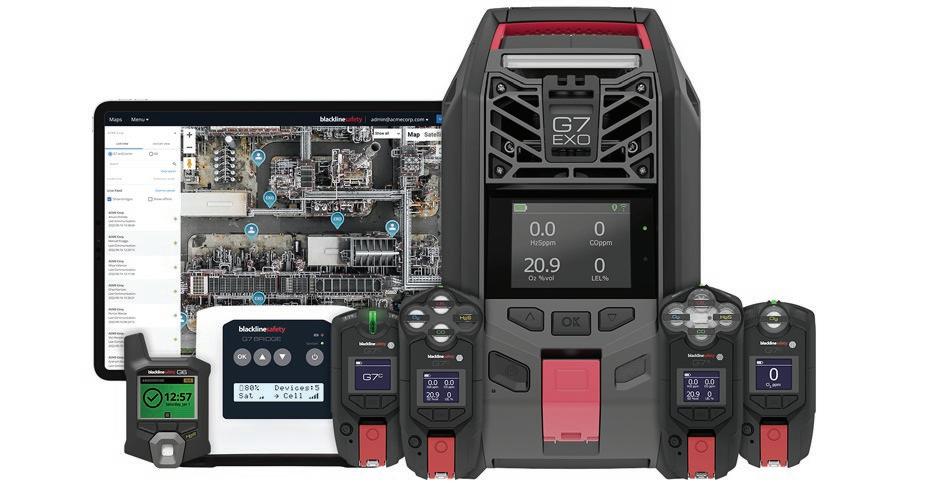
FIRE AND RESCUE INTERNATIONAL | 49 Volume 6 | No 6 Upcoming events
Back to Contents
Saryx Engineering Group (Stand D05) will showcase its awardwinning digital health and safety solution HSEC Online® at A-OSH Expo. The cloud-based solution works to eliminate the risks often encountered with a manual health and safety filing system by allowing companies and contractors to securely capture, store, distribute and manage health and safety document compliance digitally and in real-time. HSEC Online® enables organisations of all sizes and industries reach zero harm by minimising the risk of non-compliance.

GfG (Stand C06) specialises in gas detection, with safety as a priority. Products include portable gas detectors for personal protection and fixed gas detection systems that monitor entire sites. On offer are a wide variety of instrumentation with the most advanced sensor technologies for detecting flammable and toxic gases and vapours and oxygen.
Runrite’s alcohol testers are designed to ensure safe and responsible workplace environments. The company also specialises in compliance level gas detection, providing safety for employees working in hazardous environments. Runrite is excited to showcase the brand new Alcolizer Centurion Quantum on its Stand AA08 at the Expo this year.

As the owner of the KuduWave, VBS (Stand D02) brings hearing testing to millions of people across all continents. The KuduWave is an industry-credited, clinically validated diagnostic audiometer that is fully boothless and can seamlessly integrate bone conduction and use high-frequency testing for screening and full diagnostic tests. The KuduWave is enabled with telemedicine, allowing users to test and diagnose patients
in real-time in almost any location, including remotely.

In addition to thousands of products and technologies on show at the four co-located shows, A-OSH Expo visitors will benefit from the new products display, the premier visitor lounge, the SAIOSH free-to-attend Seminar Theatre powered by SAIOSH and the free-to-attend Working at Height Theatre. “The seminar theatres are characterised by high-quality topics and themes, presented by respected spokespeople in the occupational and safety space,” says Anderson.
Pre-register to visit A-OSH Expo for free here: https://tickets.tixsa.co.za/ event/a-osh-expo-south-africa-2023.
To find out more information about exhibiting at A-OSH Expo 2023, visit the website at www.aosh. co.za or contact zelda.jordaan@ montgomerygroup.com.
Engage with A-OSH Expo 2023 on social media using the show hashtag #A-OSH2023.
50 | FIRE AND RESCUE INTERNATIONAL Volume 6 | No 6 Upcoming events
Back to Contents
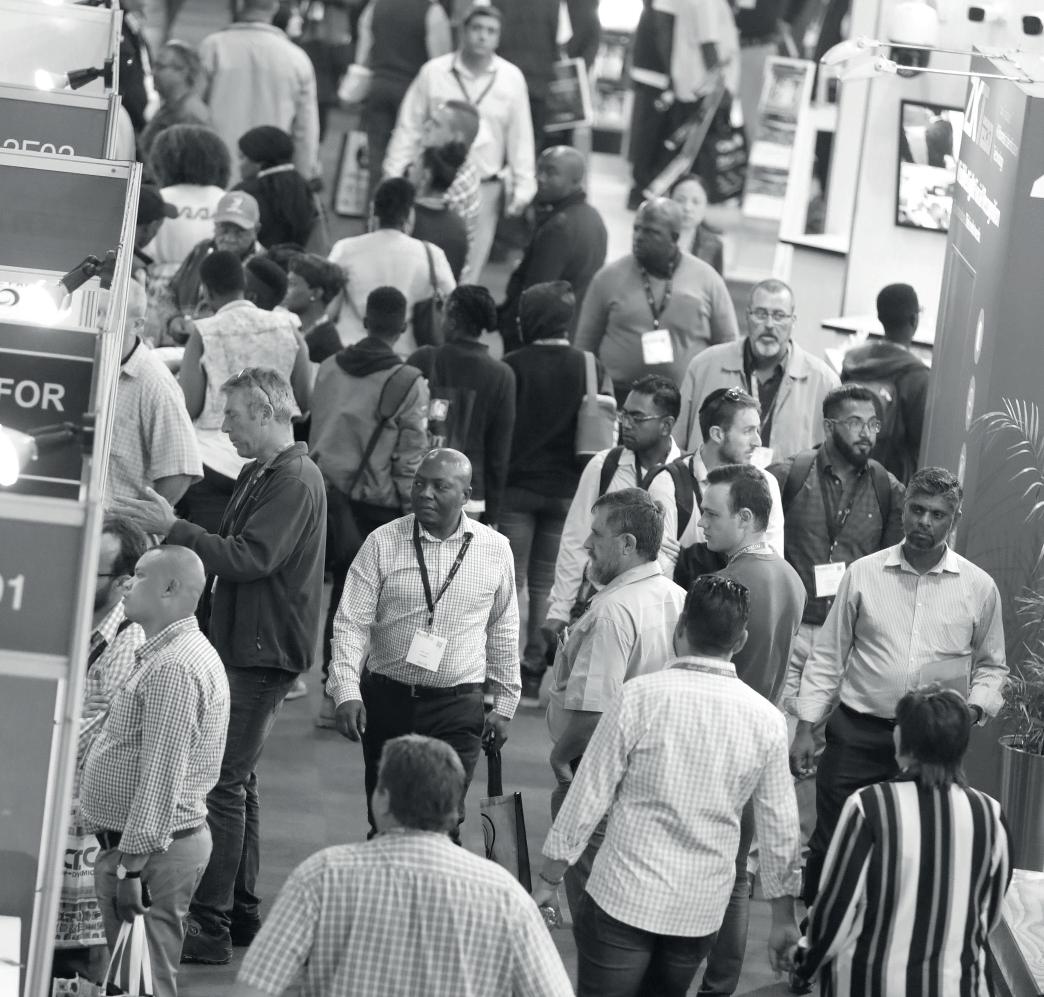






Firexpo 2023: equipping industry professionals with optimal fire detection and management solutions
Held at Gallagher Convention Centre in Midrand from 6 to 8 June 2023, Firexpo 2023 not only provides visitors with access to a large range of fire detection and management technology and services but furthermore equips them to make optimal decisions about solution selection.
According to an article in SecurityLinkIndia, fire detection equipment is generally expected to last 10 years; Fire Industry
Association (FIA) guidance on the life expectancy of a fire detection and alarm system issue. “However, the same equipment will often remain in place for up to 25 years. In a national survey carried out with healthcare fire officers, 50 percent of respondents described their system as between 10 to 20 years old, with a further 13 percent saying it was over 20 years old. Old systems tend to be difficult to manage due to reduced system reliability. Varied faults can cause false alarms and unnecessary disruption to hospital operation and this can result in fines. The biggest issues come when the system cannot be maintained any longer due to component obsolescence or due to becoming unsupported by the manufacturer.”

“This is one issue, amongst many, that continues to challenge risk managers, building/facilities managers and occupational safety and health (OSH) professionals. However, by attending Firexpo, visitors can discuss these issues with the many fire detection specialists exhibiting at the Expo. Live demonstrations and in-depth
solution-finding are the order of the day at Firexpo, allowing visitors to leave the Expo equipped with a better understanding of what will work for their specific needs,” says Mark Anderson, Portfolio Director at Specialised Exhibitions, a division of Montgomery Group.

Firexpo is strategically co-located with the three-decades-old Securex South Africa, the well-established A-OSH Expo and the Facilities Management Expo, allowing visitors to make the most of their time at the event.
Visitors will be able to see fire detection products in action from leading suppliers including G2 Fire (Stand FC01). In partnership with Carrier, G2 Fire will be showcasing some of the latest products from its portfolio. On display will be the new ZP2A range of fire alarm panels. G2 will have experts on hand to go through the Edwards Public Address and Voice Alarm equipment for those interested in expanding into the evacuation market. Other equipment, such as Modulaser, will be on show, with sales and technical support.
Fire Brand Solutions (Stand FD02) has been blazing a trail in comprehensive fire safety services since 2014, with risk assessment surveys, design, supply and installation of high-quality fire safety systems and equipment. The company prioritises the health and safety of personnel and minimises environmental impact.
Other attractions at the four co-located shows include the FPASA Conference, the SAIDSA Techman Competition, the OSPAS Awards, the SAIOSH Health and Safety Conference, the SAIDSA and ESDA breakfast, the K9 Law Enforcement demo, the new products display and the premier visitor lounge.
52 | FIRE AND RESCUE INTERNATIONAL Volume 6 | No 6
Upcoming events
Mark Anderson, Portfolio Director at Specialised Exhibitions, a division of Montgomery Group
Back to Contents
Firebrand technician inspecting a fire detector
In addition, the following free-to-attend seminar theatres are packed full of relevant and topics sessions:
• Securex Seminar Theatre
• Facilities Management Seminar Theatre powered by Broll
• SAIOSH Seminar Theatre
• Working at Height Theatre
Industry body support for Firexpo lends great impetus to the value of attending the Expo. “FPASA can get the inside scoop on industry trends and the competition, in addition to meeting with clients and increasing our brand’s visibility. We look forward to engaging with attendees, introducing them to the potential risks of our trade and sharing how we strive for risk mitigation through professional training across southern Africa,” says Christine van der Westhuizen, audit, risk, compliance and office manager at FPASA.
Nichola Allan, Cchairperson at SAQCC Fire, says, “SAQCC Fire finds Securex South Africa and Firexpo of particular benefit in our ongoing efforts to educate the end users of fire equipment into what is required when appointing contractors. We find the exhibition attracts those individuals both in companies and the insurance industry that we are trying to reach and over the many years we have exhibited, this exhibition has proved to be one of our major marketing successes.”
“The FDIA’s goal is to lead the industry in the right direction. Upholding the values and standards and making sure that it flows through in all areas of the fire and gas industry. Both Securex South Africa and Firexpo play a huge part in achieving this goal, by creating the space for us to assist and advice where required. It also



gives the FDIA the opportunity to build relationships within the industry and open the gateway in communication between the FDIA and the industry,” says Avonia Hanssen, marketing officer at FDIA
Register for free attendance at Firexpo here: https://tickets.tixsa.co.za/event/ firexpo-south-africa-2023
To find out more information about booking a stand at Firexpo 2023, visit the website at www.firexpo. co.za or contact Zelda Jordaan on: +27 010 0033082 or zelda.jordaan@ montgomerygroup.com.
Engage with Firexpo 2023 on social media using the show hashtag #Firexpo2023
FIRE AND RESCUE INTERNATIONAL | 53 Volume 6 | No 6 Upcoming events
“Held at Gallagher Convention Centre in Midrand, Firexpo 2023 provides visitors with access to a large range of fire detection and management technology and services”
Firebrand sprinkler
Back to Contents
G2 Fire fire alarm panel
Disaster management: Technology saves the day


in 2022. We can look at Nigeria, Mozambique or South Africa, where industries, especially mining and transport, were affected as a result.
Water, fire, wind - all of these can serve and help people, but they can also destroy and kill. We cannot completely protect ourselves from natural elements, so all we can do is to be as prepared as possible, have thought-out scenarios and, when such a disaster strikes, be able to manage the situation quickly and effectively and save as many lives and property as possible. Modern technologies permeate every aspect of our lives and logically have their place in disaster management as well. Let’s look at specific examples of how advanced technologies can make our work easier and safer.
Cyclone Idai, which hit Mozambique, Malawi, Zimbabwe and Madagascar in 2019, is recorded in history as one of the most destructive cyclones of the entire southern hemisphere. It claimed the lives of more than 1 000 people but it is estimated that more than three million people were affected. People suffered not only from the tropical storm itself but also from the subsequent massive floods and the spread of diseases such as cholera. The cyclone also seriously damaged infrastructure, including those for transportation and power. People’s access to services, even
crucial ones like health care, was severely constrained.
Based on these experiences, a project was launched in collaboration with the local government under the UNICEF banner to develop an application that would be able to predict the probability and extent of floods in southern Malawi. This system used artificial intelligence to analyse data from weather stations and groundlevel sensors to predict floods and alert communities in advance. Floods remained a huge problem for Africa
However water is not the only threat, disastrous flames frequently ravage African nations. NASA is one of many organizations that map, record, and evaluate their impact. But in the most critical moments, it is always essential to know how to react and get people out of danger from the element. A number of international organizations are helping out in Africa and they are using modern applications from software companies that can tailor proven technologies to their needs.
What can such a solution look like?
Paper maps are a thing of the past In the case of large search operations, rescue operations during floods or evacuations in large fires, nothing is more important for a commander than having a perfect overview of their people in the field. Whether it be fire fighters, rescuers or humanitarian workers. Without effective communication and coordination, confusion arises, tasks
54 | FIRE AND RESCUE INTERNATIONAL Volume 6 | No 6 Disaster management technologies
Several organisations are now using modern mapping platforms that act as an electronic shared map
Back to Contents
The GINA system in the command tent during a forest fire fire drill
are not carried out effectively and important information can be lost in the hectic work pace.
Several organisations are now using modern mapping platforms that act as an electronic shared map. In this, commanders can display the position and movement of their units, their speed, equipment, can directly send them instructions, as well as all available information. These applications allow marking of searched areas or conversely, setting out areas for units to move in.
All participants share photos and videos with each other, even in real time via stream. Records created by workers in the field are projected onto the map, it can be sending the position of a buried well with drinking water, unexploded mines or impassable roads. Digital maps are particularly suitable for activities involving multiple organisations that have to cooperate. Modern systems are so clever that they can link devices of different organisations and technologies. The map displays data from radios, trackers, cameras, tablets or mobile phones.
World-class help from the Czech Republic
Such a sophisticated system is offered by a number of companies, many of which have been proven in disaster management. For example, missions of the United Nations, Mercy Corps or the Red Cross is helped by the Czech company GINA Software. Their technologies are

used by rescue services, private security companies and humanitarian organizations not only in Europe but also in the Middle East and Africa. They have been proven, for example, in floods, tornadoes, large forest fires, search missions but also help Czech professional and volunteer fire fighters every day in routine tasks, which are more than 150 000 a year.

Of course, there are many companies on the market with disaster management solutions. Their systems are based on the latest knowledge in the field and incorporate innovative technologies that allow them to offer more and more features while reducing the resulting cost. The importance of a user-friendly and clear environment that allows new users to get started immediately without the need for complex and lengthy training is also increasingly coming to the fore.
You have needs, we have solutions
Each customer can choose from the solutions offered by different companies and get it tailored to their needs. For some, the emergency tablet is suitable, equipped with special navigation that guides vehicles to the scene quickly and accurately, but the tablet also serves as a communication tool with the command centre while they are responding to a call. “We now have these GINA tablets in almost every vehicle. Of course, the volunteer units also have them, so we can see their operations and vice versa. I think it makes the fire fighters’ work much easier even at the scene,” says Jakub Mačát, a Czech professional fire fighter, praising the technology.

On mobiles, humanitarian workers can use the app, which allows efficient data collection and photos from the field and in case of emergency, can call for help with one button, sending the exact location and automated audio message. For spokespersons, the mobile app is ideal, providing a clear but information-rich overview of current and completed operations, supplemented with photos. This is all complemented by the possibility of connecting sensors, vehicle locators, industrial cameras or drones.
The possibilities of using innovative technologies in the field of disaster management are endless and still improving. That is good news for everyone because thanks to it we can save lives. We can save lives through technology.
FIRE AND RESCUE INTERNATIONAL | 55 Volume 6 | No 6
On mobiles, responders can use the app, which allows efficient data collection and photos from the field and in case of emergency, can call for help with one button
Disaster management technologies Back to Contents
Tablets also serve as a communication tool with the command centre
History of fire fighter gloves
Historically, fire fighters have not had access to the same level of protective clothing used today. Fire fighting is a dangerous profession that requires specialised equipment to effectively and safely mitigate a fire emergency. Originally, fire fighters lacked the specialist equipment to be able to enter buildings, with many fires being dealt with outside a structure.
Early in the history of fire fighting, a fire fighter’s outer clothing was more for warmth and dryness than for protection from fire.
Since it is clear that fire fighting techniques will not change in the near future, the burden of protecting hands and wrists and thereby reducing or eliminating most injuries, lies primarily with the fire fighters’ gloves. Therefore, gloves must be constructed to ensure adequate levels of protection.
The personal protective equipment structural fire fighters wear today is drastically different than what they wore in the early years. Early gloves used by fire fighters were typically made of leather.

Post-war uniforms incorporated major technological improvements in fabrics, which reflected that the brigades were now tackling more hazardous situations, such as industrial accidents and complex road traffic accidents.
Fire resistant asbestos suits, hoods, gloves and aprons used in the 1920s have been replaced with safer and more effective epoxy coated aluminium fibres and materials that utilise complex fire resistant and retardant chemicals.
Today’s gloves are made of a blend of high-performance fibres making them resistant to heat and fire. Dexterity is the key issue though.
Gloves protect the fire fighter’s hands from the heat and sharp objects they encounter as well as to protecting them while using the powerful equipment, ropes and hoses. Past fire fighters had to supply their own leather gloves. Gloves today are made of a threelayer fire and heat resistant, highperformance fabric such as Kevlar.
The gloves are required by the US National Fire Protection Association (NFPA) to withstand and protect the fire fighter from flame, heat, vapour, liquids and sharp objects.
Many types of hand protection are available to fire fighters today, the most common being the work glove and the structural fire fighting glove.
Work gloves are a must for all fire services. They are used when gloves are required but actual fire fighting gloves are not. They allow better mobility to perform various types of functions from relaying hose beds to vehicle maintenance. Work gloves are usually made of leather or a leather-like material.
Extrication gloves are similar in design and appearance to auto mechanic’s gloves but are made of a heavier rip-proof and punctureresistant material such as Kevlar while still lightweight enough to allow manual dexterity to operate rescue equipment and sometimes enough to take a victim’s pulse. These are used in urban search and rescue, vehicle extrication and related applications but are not rated for firefighting.
For an actual working fire, structural fire fighting gloves must be worn. Structural gloves tend to be the last piece of protective equipment to be donned; usually because the free dexterity of the fingers is required to perform functions such as properly placing a self-contained breathing
apparatus (SCBA) mask on and accurately tightening a helmet strap. The gloves will fit over the wristlets and under the distal part of the coat sleeve, ensuring full enclosure of the latter arm.
Gloves are designed to protect from extreme heat and various penetrating objects and to allow dexterity. Usually, the latter is sacrificed to give adequate protection from heat and sharp objects. Newer gloves are more lightweight and don’t lose their dexterity when they dry after becoming wet, the way leather gloves may.
Based on NFPA research, PPE was drastically improved. This culminated in the NFPA 1971 Standard on Protective Clothing for Structural Fire Fighting. It specifies “the minimum design, performance, safety, testing and certification requirements for structural fire fighting protective ensembles and ensemble elements that include coats, trousers, coveralls, helmets, gloves, footwear and interface components.”
The evolution of fire fighter’s helmets, clothing and personal safety devices have certainly enabled more people to be rescued from the death sentence that a fire was. Without the PPE of today, fire fighters would be unable to enter burning buildings to rescue those trapped inside nor would they be able to extinguish the fire so quickly.
The death rate by fire would skyrocket as would the destruction made by the inability to rapidly contain a fire.

Large strides have been made in the evolution of fire fighter’s personal protection equipment. As a result, the fire fighters of today are much safer than those of decades past whenever confronted with a roaring inferno or even a small fire.


HERITAGE
Volume 6 | No 6 56 | FIRE AND RESCUE INTERNATIONAL
What’s On?
June
14 to 17 June 2023
112 Rescue, Dortmund, Germany
Advancing technology and the rise in extreme weather phenomena pose a constant challenge to rescue forces and fire fighters and exacerbate the need for an annual platform that showcases cutting-edge innovations.
Venue: Messe Dortmund, Germany
Visit: https://www.112rescue.de/en-gb
6 to 8 June 2023
Securex, A-OSH Expo, Facilities Management Expo and Firexpo 2023




Securex 2023 will be held at the Gallagher Convention Centre in Midrand, together with A-OSH EXPO, Facilities Management Expo and Firexpo. Visitors and exhibitors benefit not only from the co-located exhibitions but furthermore from the Securex Seminar Theatre, the SAIOSH Seminar Theatre, the Facilities Management Expo and the Working at Height Theatre.
Venue: Gallagher Convention Centre, Midrand, Gauteng, South Africa
Visit: www.securex.co.za, www.aosh.co.za, www. fmexpo.co.za or www.firexpo.co.za
8 to 11 June 2023
2023 International Hazardous Materials Response Teams Conference
The International Hazardous Materials Response Teams Conference (Hazmat) is a four-day event that will be held at the Hilton of Baltimore, Maryland, with an additional pre-conference day on 7 June 2023. Attendees are provided the latest classroom, hands-on and field tripbased training on topics covering all aspects of Hazmat. The training offered at the Hazmat Conference offers immediate, practical and valuable information designed to ensure you successfully meet the demands of Hazmat response in today’s challenging environment.
Venue: Hilton Baltimore, Maryland, US
Visit: www.eventscribe.net/2023/Hazmat
July
18 and 20 July 2023
KwaZulu-Natal Industrial Technology Exhibition (KITE)
After pioneering the way for a return to in-person exhibitions in February this year, the KwaZulu-Natal Industrial Technology Exhibition (KITE) is returning between 18 and 20 July 2023 at the Durban Exhibition Centre.
Venue: Durban Exhibition Centre
For more information visit: www.kznindustrial.co.za
August
16 to 18 August 2023
Fire Rescue International FRI Kansas City, USA
Fire Rescue International (FRI) is a forum for current and emerging fire, rescue and emergency service leaders. FRI brings together thousands of fire service chiefs and officers from the United States and around the world to exchange ideas, to learn from experts and to see the latest equipment, products and services for emergency responders. Experience the excitement through interactive exhibits, on-floor education, live demonstrations and technology-focused pavilions. There is also an expanded educational program with tracks focusing on leadership, fiscal management, safety and much more.
Venue: Kansas City Convention Centre, Kansas City, Missouri, USA
Visit: https://2023fri.eventscribe.net/index.asp
30, 31 August 2023

Fire Protection Conference in St Pölten University of Applied Sciences
The FSE Ruhrhofer and Schweitzer GmbH is organising the 19th Fire Protection Conference at the St Pölten University of Applied Sciences. The conference is aimed at all experts working in preventive fire protection authorities, fire brigades, insurance, engineering, expert architects and the industry.
Venue: St Pölten University of Applied Sciences, Austria
Visit: www.fse.at/tagung
September
13 September 2023
International Day for Disaster Risk Reduction 2023 (IDDR)
Visit: https://iddrr.undrr.org/
14 to 17 September 2023
ISAF Fire and Rescue 2023
The 27th International Fire, Emergency, Search and Rescue Exhibition, the only exhibition held in Turkey for many years in the fields of “Fire, Emergency and Search and Rescue”, is preparing to bring together all segments of the sector. ISAF Fire and Rescue is a fire exhibition that covers all processes related to fire, although the fire exhibition is considered as the process only after the fire. ISAF Fire and Rescue is an exhibition where all products ranging from the first stage to the last stage of fire safety are exhibited and followed by users at every levels.
Venue: İstanbul Fuar Merkezi Yeşilköy, Turkey
Visit: www.expointurkey.org/isaf-fire-rescue-2023
What’s On?
2023
Back to Contents
The loneliness of leadership
Statistically, there are fewer leaders today due to many reasons but what those who choose not to lead often fail to realise is this:
Those who step up and lead are not perfect.
Those who choose to lead are not better than anyone else nor think more of themselves; in fact they often struggle with insecurity and doubt more than you know.
Those who lead are often maligned, slandered and opposed by those who would rather criticise than do the hard work of resolving long standing issues that leaders tackle head on.
Those who choose to lead suffer from depression as they often wonder if their efforts are worth it. Many leaders fail to see the fruit of their labour in their own lifetime yet they keep working.
Those who choose the lead care more about others and their calling than they do about themselves. And they often suffer divorce and relational conflict because the majority cannot understand why they sacrifice so much to receive so little.
Those who choose to lead are often the first to suffer from political, personal and spiritual attacks because the devil doesn’t come after the complacent.
Those who choose to care enough to fulfil the calling on their own heart have smaller bank accounts but have larger dividends paid to them by the lives they impact.
Those who step in front of adversity and take the brunt of a punishment of a wrong that was not their own understand that they were made to shield those in their influence.
Those who spend sleepless nights on projects, plans and praying fervently for change in a world that often rejects them will not be forgotten.
Those who love while others hate and withhold harsh words in the face of those who spit anger at them are stronger than we realise.
Those who lift up the broken only do so because they know that they too were once lifted up by someone else.
In closing, if you know a leader who works fervently, know that you only see a portion of their efforts. In reality, they never stop.
So the next time you feel like criticizing the leaders around you; take a moment and consider these words mentioned here.
Consider that they care about the mission and people so much that they are willing to endure such hardship not for recognition but for the sake of an outcome that only God and they can see.
Support our leaders! Pray for them and their families!
Take a moment and look around you. The things you enjoy currently may have been bought and paid for by a lifetime of personal sacrifice. Let us not destroy our future by attacking those who work to improve it.
Source: Andy Starnes
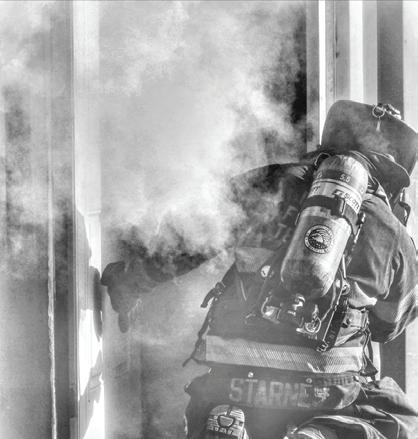
58 | FIRE AND RESCUE INTERNATIONAL Volume 6 | No 6 Strap Poem
Back to Contents














































































































































































































































































 By Etienne du Toit: AIFireE, PrDM, B Tech: Fire Technology (Pretoria Technicon)
By Etienne du Toit: AIFireE, PrDM, B Tech: Fire Technology (Pretoria Technicon)







 By Oliver Wright, chief executive officer, South African Private Ambulance and Emergency Services Association (SAPAESA)
By Oliver Wright, chief executive officer, South African Private Ambulance and Emergency Services Association (SAPAESA)
















































